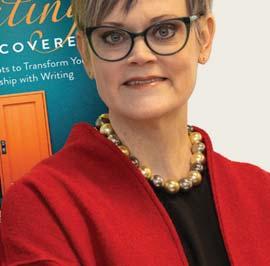








Powered by
Powered by

In partnership with Medical Mutual, we are offering an expanded ChamberHealth® program to provide you – our members – with premium health insurance coverage while saving you money through group buying power. Through this partnership, we are now able to offer ChamberHealth insurance plans to businesses from 1 to 500 employees in the state of Ohio – an expansion of the program that was previously only available to companies from 2 to 99 employees.
ADDITIONAL PLAN OPTIONS INCLUDE:
• Prescription drug coverage
• Wellness programs
• Identity theft resolution and remediation services are offered at no additional cost.

Through ChamberHealth, small businesses and sole proprietors – a first for the ChamberHealth program – can partake in a self-funded insurance plan. Being self-funded has many benefits, including:
• The ability to keep costs low since MEWAs are not subject to some of the Affordable Care Act’s (ACA) mandated benefits and taxes
• The cost of benefits reflects the unique health of the company and its employees, recognizing that a healthier team should create a better benefits cost outcome
• All benefit options are tied to Medical Mutual’s large network of doctors and hospitals, including TriHealth, the Christ Hospital Health Network, and Mercy Health TRADITIONAL COPAY AND HIGH-DEDUCTIBLE PLANS WITH HSA




Metro provides safe, reliable, economical rides to more than 35,000 people each day.
But Metro also achieves its mission to drive economic growth and improve quality of life:
· Connects 93,400 jobs at over 740 employers to transit service.
· Provides 24-hour access to more than 220,000 Hamilton County jobs.
· Generates $850 million in total wages for the local economy.
· Increases independence and mobility for people with disabilities with 24-hour Access service.
· Awards more than $317 million to 100+ infrastructure projects throughout the county under the Metro Transit Infrastructure Fund.
· Distributes $500,000 annually to Everybody Rides Metro so more than 100 partner agencies can remove transportation as a barrier to jobs, healthcare, and more.
Whether you ride the bus or not, Metro is your way to go for a brighter, more connected future in Hamilton County.
www.go-metro.com








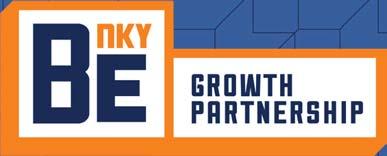








10 ARTS & CULTURE
HOME IS WHERE THE ART IS The Children’s Theatre of Cincinnati renovates the Emery Theater as its new home
12 SPORTS SERIOUS ABOUT SPORTS Ben Huffman talks about leading the new Cincinnati Regional Sports Commission
14 PHILANTHROPY FULL SPEED AHEAD
Meals on Wheels’ expansion will tackle surging demand for senior services
16 ARTS & CULTURE ARTISTS MEAN BUSINESS
The new Cincinnati Artist Network helps creatives build businesses
18 FINANCE BANKS MAKE BIG MOVES
New leadership and major acquisitions highlight summer activity

50 ASK ME ABOUT
Get to know Andrew Aiello of Metro/ SORTA, Darcie Bristow of Ruby Culinary, and Elizabeth Pierce of Cincinnati Museum Center
52 PHOTO ESSAY: ALL FOR ONE IN NKY
The OneNKY Center opens in Covington as home base for local growth organizations to collaborate with each other and the community
08 BY THE NUMBERS
Here’s how Cincinnati ranks in job and population growth with 19 peer cities, from Atlanta to Lexington, along with projected growth in each of the region’s 15 counties.



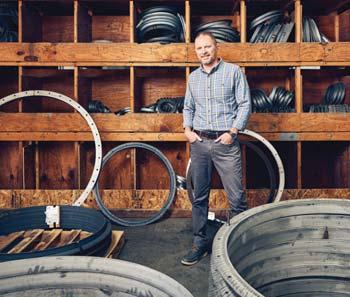
22
CINCINNATI’S PLACE IN THE SPACE RACE
How we became one of the country’s fastest-growing regions for office-to-housing conversions.
28
CHARTING COURSE FOR THE NEXT FOUR YEARS
Aftab Pureval and Cory Bowman discuss their track records and priorities ahead of November’s city elections.
36
WAVING THE FLAG FOR SMALL MANUFACTURERS
Here are four unique stories behind Cincinnati’s booming manufacturing sector.
42
WHY JIM KOCH STILL DIGS
Born into a brewing family here, the Boston Beer CEO appreciates our German traditions and strong work ethic.
Riesenberger
As the seasons turn and Cincinnati’s neighborhoods fill with the colors of fall, I’m thinking about change, which is something that’s natural and necessary for growth.
Inside this fall issue of Realm, you’ll find a look at how our city is changing by converting office buildings into much-needed apartments that bring renewed energy to our urban core. You’ll read about manufacturers who have been in business for decades and are changing to remain competitive. You’ll discover executive profiles highlighting the people who are not only adapting to change but also leading it, and you’ll read about the shifts taking place in banking and finance and what those changes mean for businesses and individuals across our community. We also break out highlights from the Chamber’s State of the Region report examining the forces influencing Greater Cincinnati’s growth and momentum.

In November, Cincinnati voters will head to the polls to choose the next leaders of our ever-evolving city. This issue features interviews with mayoral candidates Aftab Pureval and Cory Bowman. The general election includes 26 candidates running for City Council and a few charter amendments on the ballot as well. This moment offers us a powerful opportunity to think deeply about the kind of city we want, to engage with the ideas and visions that will guide our future, and to elect leaders who can bring us together to create a growing, thriving, and changing region where everyone belongs.
Change is also deeply personal. Jim Koch, Cincinnati native and founder and CEO of Boston Beer Company, recently returned to the helm of the company he started 35 years ago with a single recipe and a bold idea. His story reminds us that leadership is often about knowing when to embrace continuity and when to step back in to guide a new chapter.
At the Cincinnati Regional Chamber, we believe change creates opportunity. My hope is that this issue of Realm not only informs but also inspires—that we use this season of transformation to reflect, engage, and help steer our region toward its next chapter.
BRENDON CULL
BCull@cincinnatichamber.com





Whether you’re a start-up or a mid-size company celebrating a landmark anniversary, Heritage Bank can provide the banking solutions and expertise essential to your success. We’re small business banking specialists inspired by our customers’ vision, ingenuity and grit. We’re a community bank vested in the region you call home.
• Recommended by business customers 5Xs more often than average business bank.
• Efficient conventional and SBA lending.
•Agile, responsive bankers.
• Local ownership and decision making.
• Robust Treasury Management Services.







In Cincy, meetings aren’t just events, they’re experiences waiting to be crafted. Discover Cincy’s endless meeting optionsthey’re Fresh, Bold, and New!
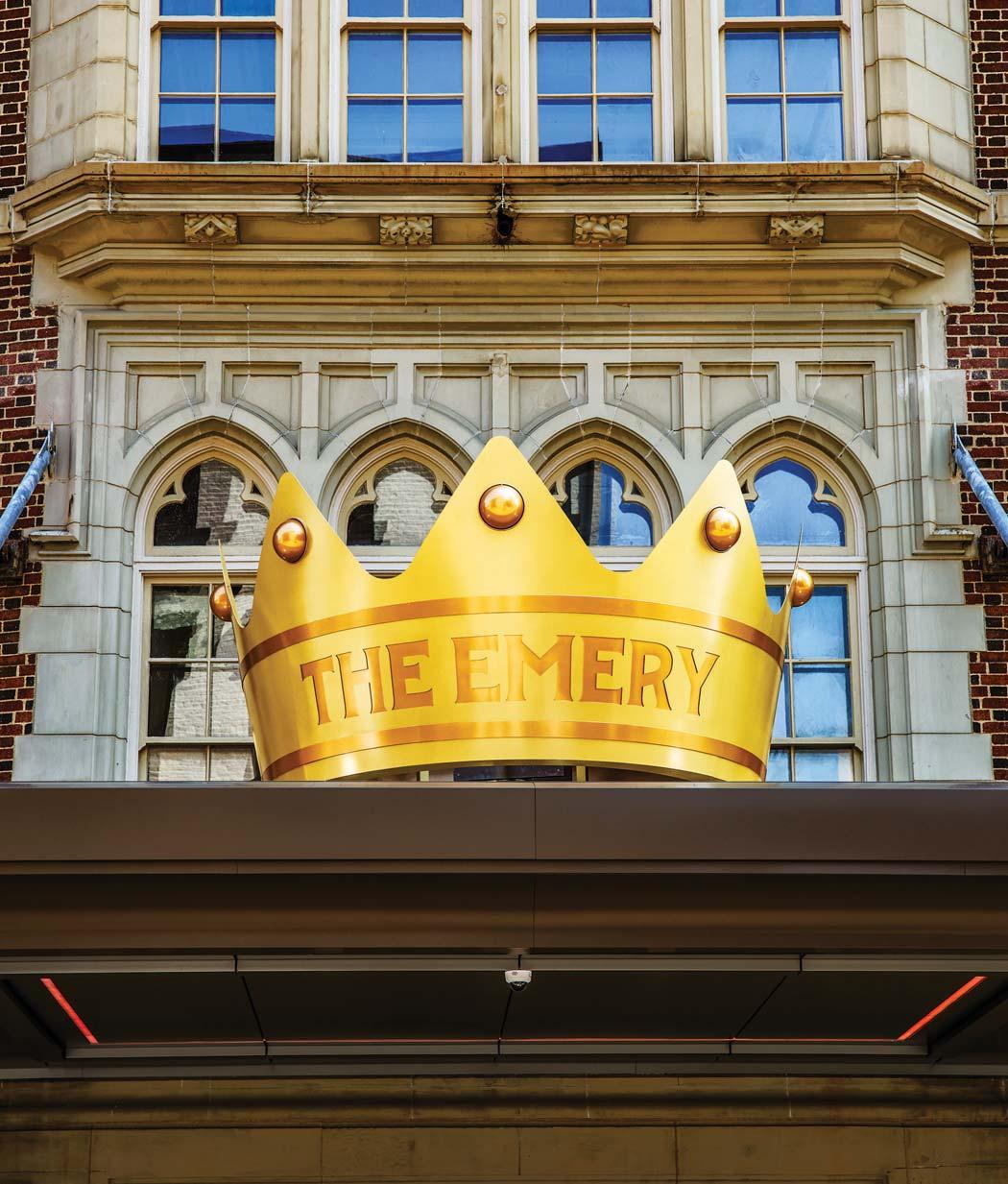
THE EMERY THEATER BECOMES ANOTHER CROWN FOR THE ARTS SCENE THIS FALL.

Get a jump on news about the relaunched Cincinnati Regional Sports Commission, the new Cincinnati Artist Network, and mergers, acquisitions, and leadership changes in the local banking world. And catch up on expansion plans at Meals on Wheels and highlights from the annual State of the Region report.
The 2025 State of the Region report is a snapshot of how the 15-county Cincinnati region is growing, both in net terms and in relation to its peer cities, and what opportunities and challenges lie ahead. Cincinnati ranks 10th in size among the 20 peer cities studied, from Atlanta (6.4 million population) to Lexington (533,000), and 11th in real gross domestic product (GDP). Cincinnati has the highest GDP among Ohio metro areas.
GROWTH IN CINCINNATI REGION [Total
The Children’s Theatre of Cincinnati, one of the country’s largest and oldest kid-focused live theater organizations, reopens the Emery Theater in October after a $51.5-million renovation. The season’s first show is The Wizard of Oz: Youth Edition, whose heartwarming lesson is, “There’s no place like home.”
The Children’s Theatre, founded in 1919, performed at the Emery from 1949 to 1969 and then moved to the Taft Theatre for public shows. Owning its own theater now gives TCT the opportunity for longer runs for each show and for booking touring children’s events.
The Emery’s original capacity was around 2,200, but TCT’s renovation resulted in a reduction to 1,534 to accommodate larger seats and new amenities such as a larger lobby, accessible full-service elevator, and a crying/sound sensory room.
The renovation allowed TCT to create the most technologically advanced theater space in the U.S. A new rotating lift allows sets to be raised from under the stage, while projection mapping turns the stage’s back wall and entire proscenium into LED screens.
Philanthropist Mary Emery funded the theater’s construction in 1911 as home for the Cincinnati Symphony Orchestra. After the CSO moved back to Music Hall 25 years later, the Emery hosted concerts, speakers, and TCT. But it’s sat empty and unused for two decades.


BEN HUFFMAN LEADS THE NEWLY FORMED CINCINNATI REGIONAL SPORTS COMMISSION.
—ELIZABETH MILLER WOOD
IIt’s honestly been a long time coming. Cincinnati’s peer cities—namely Indianapolis, Louisville, and Columbus—have had formal commissioning entities that bring high-profile sporting events to their regions. Now Cincinnati does as well.
A joint effort between tourism agencies on both sides of the river as well as corporate and small business leaders, the Cincinnati Regional Sports Commission seeks to bid and win sporting events that will raise the city’s profile and drive economic impact. Executive Director Ben Huffman was recruited from the Warren County Convention & Visitors Bureau, where he served as Director of Sports Tourism for 19 years, and says Cincinnati is ready to take sports tourism into a new era. “What really sold me on leaving a great opportunity for a better opportunity is the public and private support,” he says.
From hotels and restaurants to large corporations and small businesses, there’s a true team spirit at play in this new organization. “The more people we can get involved, the more events we will get,” Huffman says. “It’s been really refreshing over my first two months to see how many different people at different levels of our community want this to be successful.”
First on deck under Huffman’s watch is the U.S. Steinholding Championship on November 22, which will host 50-60 competitors at Moerlein Lager House downtown. Though Moerlein booked the event prior to Huffman’s arrival, the Commission and the brewery will collaborate on its execution.
On the horizon, Huffman hopes to secure larger “headline-type events” such as the 2028 NFL Draft (already initiated by the Bengals) and the 2031 Rugby World Cup. Youth and amateur events will also be a focus, he says, refer-

encing a Sports ETA study saying the economic impact of youth sporting events is actually higher than spectator sports.
Huffman notes that while the positive economic impact of hosting such events may be fast and furious for the duration of the event, the “ripple effect” can last months and even years into the future. “It puts us on an international stage,” he says, which in turn creates a city that people want to move to and stay in and aids in recruiting efforts for regional employers.
Plus, the more Cincinnati proves it can handle hosting world-class events, such as the MLB All-Star Game in 2015, the more likely it is to win future bids.
For Huffman, a father of six and a life-long sports enthusiast, the delight of sports tourism is twofold: an opportunity to benefit the community and the privilege of creating “memory events” in individual lives. It’s creating those memories that will drive Huffman, the Commission, and the city of Cincinnati to recruit and host higher-profile events.
“It’s been refreshing over my first two months to see how many different people at different levels of our community want this effort to be successful.”
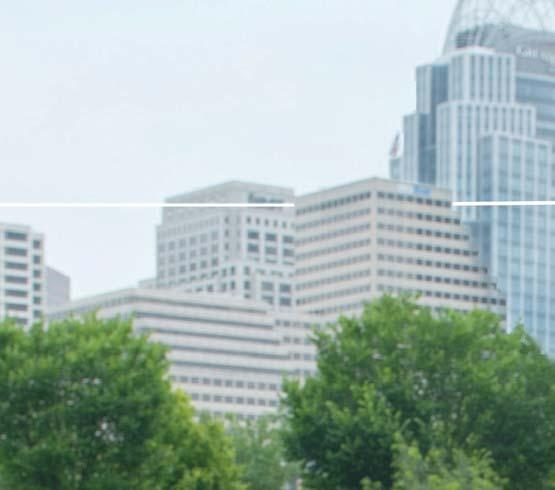





From the riverfront to our vibrant neighborhoods, every step forward begins with community. Greater Cincinnati Foundation partners with generous people like you to invest in opportunity, community vibrancy, and lasting impact right here at home.

Meals on Wheels’ expansion will tackle surging demand for senior services.
—SARAH M. MULLINS
When Mike Dunn stepped into the CEO role at Meals on Wheels last year, the organization faced a pivotal moment. The nonprofit serves 10,000 seniors across 13 counties in the Cincinnati region, producing 1.2 million meals annually—far beyond its facility’s intended capacity. With U.S. Census data projecting that older adults will outnumber children under 18 for the first time in history by 2034, he sees both an unprecedented challenge and a rare opportunity to transform how the community cares for its aging population. “We know this population wave is coming, and we’re doing our best to get out ahead of it,” he says.
To meet the aging demographic head-on, Meals on Wheels launched a $30 million capital campaign to build a new headquarters to consolidate all services under one roof in a 51,500-square-foot facility on Highland Avenue in Columbia Township. The project aims to position the nonprofit to serve three times more seniors than today and is also reimagining how Meals on Wheels operates.
The organization plans to go from 1.2 million meals to at least 3 million meals annually while introducing a private pay option that will open services to seniors who don’t qualify for traditional assistance programs. “There are plenty of folks that need and/or want our services,” says Dunn. “This option will allow us to serve a larger population and be able to generate so-

cial enterprise to further diversify our funding. The capacity expansion will allow us to reach 30,000 seniors in the future.”
The organization is also exploring opportunities to provide meals to other nonprofits that support seniors, he says.
While the name suggests otherwise, Meals on Wheels goes far beyond food delivery.
“Meals are a conduit to a relationship with a senior,” says Dunn. “It allows our driver to go into the home of a senior, to have a relationship with them, and to understand how they’re doing. It’s a welfare check in addition to providing those meals.”
The organization’s approach includes transportation services, caregiver support, digital connection programs, and even pet assistance. By bringing all staff under one roof, Meals on Wheels expects to gain efficiencies and create a new community space for classes, workshops, and other senior programming like fraud prevention or pet adoption classes. “We’re doing a lot of things to help seniors stay independent,” says Dunn. “We’re all about essential services that ultimately help seniors stay in their homes as long as appropriate and reasonable.”
The capital campaign is one of the largest fundraising efforts in organization history.

More than $22 million is already secured through gifts and pledges from individuals, grants, foundations, and corporate partners.
Dunn sees the campaign as an invitation for the entire region to participate— whether through donations, volunteer involvement, or advocacy—and to emphasize that caring for seniors is a shared responsibility. The goal, he says, is help more seniors remain independent, healthy, and socially connected.
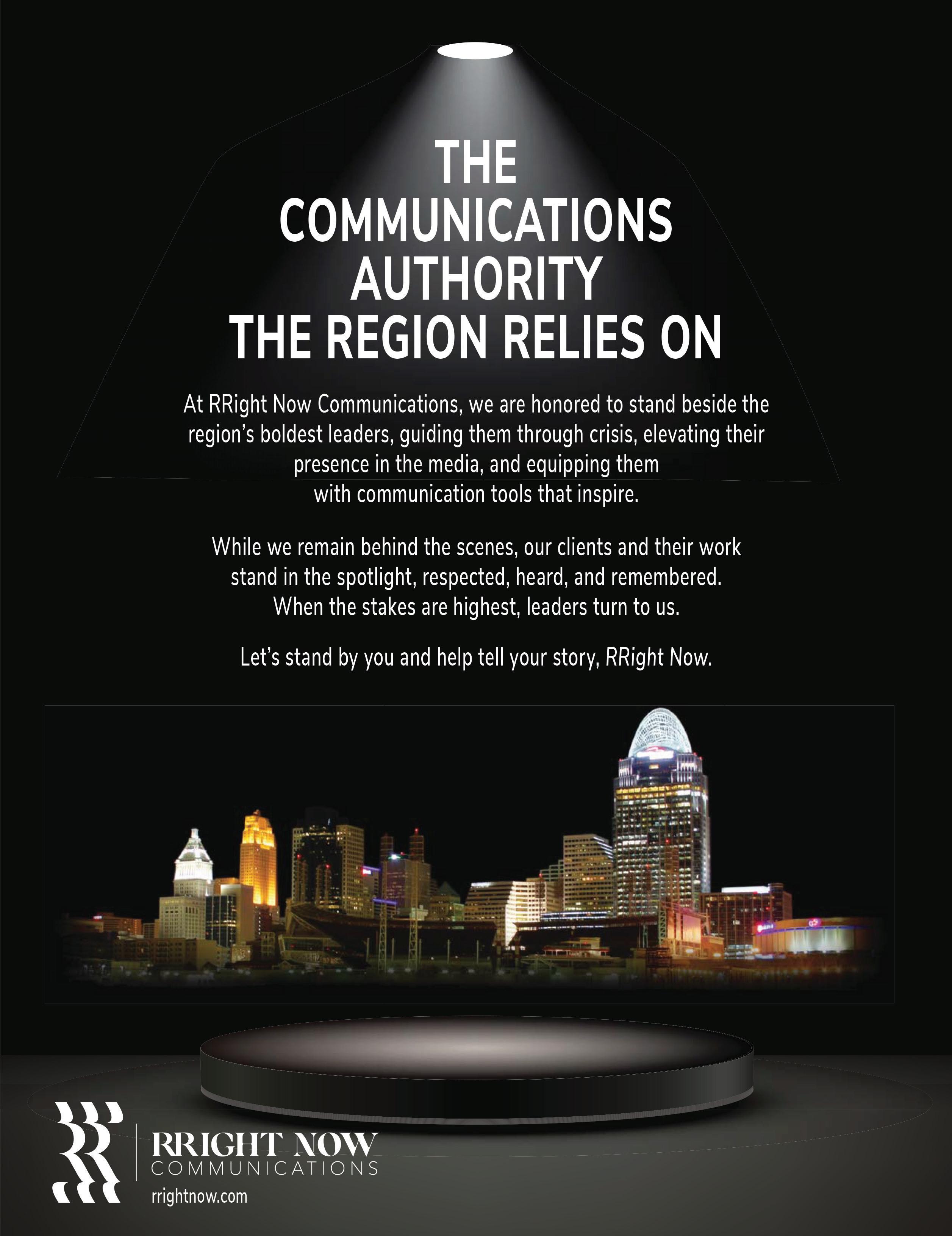

The new Cincinnati Artist Network focuses on the entrepreneurial side of building a creative business.
–SARAH M. MULLINS
Artists are often the force behind a community’s innovation and community development, but in many mid-sized cities individual creators struggle with the business side of their craft. Tasks like writing contracts, hiring lawyers, developing business plans, and managing client relationships are challenges that can make or break any business. Recognizing this gap in the artist community, the Cincinnati Regional Chamber and the Haile Foundation are launching the Cincinnati Artist Network (CAN) in the fall.
At the heart of CAN is an online directory of regional artists, but the initiative goes beyond a website. CAN is offering working artists access to the same business resources, group healthcare discounts, and networking opportunities that Chamber members enjoy. The network emerged from a 2019 Haile Foundation survey that revealed the need for entrepreneurial support in the artist community. “It found that local artists needed help when it came to being entrepreneurs,” says CAN Executive Director Tamia Stinson. “When you’re an independent artist, whether you want to or not, you’re run-
ning your own business.”
While Cincinnati maintains major art museums, performing arts organizations, and high-profile arts events, those behind the arts ecosystem—painters, ceramicists, dancers, and writers—often lack infrastructure to build sustainable businesses. Many artists are one-person operations and juggle the creative work with other tasks like marketing, clients, and finances.
“One of the things we always talk about is Cincinnati being a city for the arts,” says Stinson.
“But we forget there is no ‘the arts’ without the artists. CAN is meant to create the infrastructure to make sure they can succeed and thrive here.”
Cincinnati is recognized nationally for investing in the arts.
Cullen, artist and program manager at the Haile Foundation, “and I can tell you that artists are the future. We’re innovators, collaboratives, and creatives who are on the cutting edge of what’s next, we’re often the first sparks of progress in community development, in business development and innovation.”
“We’re creating infrastructure to make sure artists succeed and thrive here.”
The city is a mainstay on USA Today’s Top 10 Best Cities for Street Art, this year at No. 2. BLINK is one of the region’s most economically impactful events. “I’m an artist myself,” says Cal
CAN’s online directory will be the main entry point where artists can join and the public can find and hire local talent. Stinson says event planners, small businesses, corporate partners, and the community at large can connect with an artist to create branded swag, hire a musician for an event, or find a performing artist for a child’s birthday party.
Cullen says the Haile Foundation’s overarching goal is to enhance the quality of life for area residents, and the arts are key to enhancing quality. “We’re very interested in supporting initiatives and organizations to build a thriving arts ecosystem that allow artists to thrive,” she says.
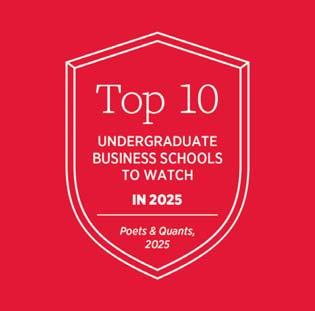
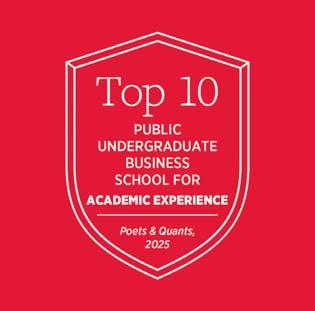

with the Farmer School of Business

Invest in Your Future

New leadership and major acquisitions highlight summer activity.
—ELIZABETH MILLER WOOD
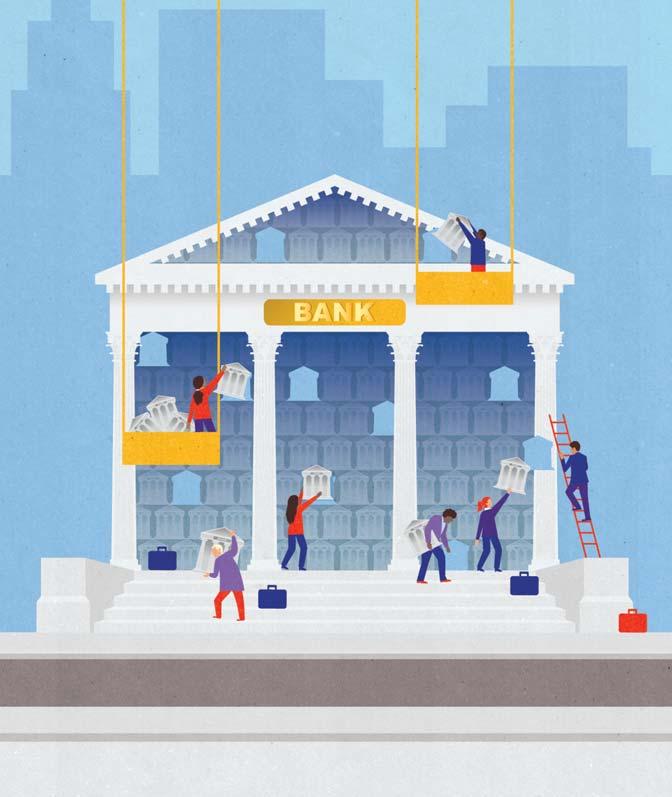
As the region’s largest locally based bank, Fifth Third Bank has long been a barometer of bank health in Cincinnati, and in recent months the company set the tone for ambitious growth and fresh leadership. Dan Feldmann was promoted to Cincinnati region president in July to replace Tim Elsbrock, a company veteran who shifted to a new position as region vice chairman in Cincinnati. Feldmann, a Fifth Third employee of nearly 25 years, will oversee the strategic growth of commercial banking, wealth and asset management, and commercial payments businesses across the Cincinnati and Northern Kentucky region as well as in Dayton, Ohio.
Fifth Third also recently acquired DTS Connex, a fintech company that will help expand the bank’s commercial payments capabilities. The Maryland-based acquisition provides cash management software for businesses with multiple locations, such as retail chains and health care providers. Processing $17 trillion in payments last year, Fifth Third is the nation’s sixth-largest commercial payments provider, processing cash payments for more than 35,000 businesses.
In other activity that appears to forecast economic stability for the foreseeable future, First Financial Bank is acquiring BankFinancial for $148 million to triple its Chicago area retail presence to 26 locations. The deal added $1.4 billion in assets to First Financial and expands the bank’s branch footprint in Cook County, home to Chicago proper, as well as DuPage, Lake, and Will counties. Once finalized, the deal will aim to grow commercial business primarily in the middle-market business lending space as well as home equity lending.
First Financial has also expanded in Northeast Ohio with the acquisition of Westfield Bancorp for $325 million, with pending regulatory approval expected to be completed in the fourth quarter of this year. The bank has made a concerted effort in the past two years to grow its commercial and wealth management presence in that part of the state, opening a regional headquarters in downtown Cleveland in June 2024.
The acquisition will establish the first First Financial retail branches in the Cleveland/Akron market. Westfield’s seven branch locations will remain change their names to First Financial.
Branch names weren’t the only local changes in the past few months, though. Steve Mullinger left his role of regional president at Huntington National Bank, the region’s fifth-largest bank, and joined Truist Bank as its Ohio market president. Billy Santos remains Truist’s Cincinnati market president.
David Burch, Huntington’s director of specialty banking and regional banking administration, has been appointed interim president for its Southern Ohio/Kentucky and Indiana region.
Interview with Kevin Rooney of Rooney IP


What sets Rooney IP apart from many other Intellectual Property Law Practices?
Kevin:
Can you explain what you mean by “personal service”?
Kevin:
when it comes to intellectual property?
Kevin:

Aren’t patents expensive to both obtain and maintain, let alone enforce? Is it worth it?
Kevin:











































Real estate trends come and go, buffeted by interest rates, changing consumer tastes, and macroeconomic realities. And then, once in a generation perhaps, a global pandemic appears out of nowhere and turns everything upside down.
Adaptive reuse has always been a key tool for Cincinnati developers, given the city’s extensive collection of intact historic buildings. Pre-pandemic, the urban core saw a wave of underutilized office buildings converted to boutique hotels: Renaissance Hotel, Kinley, Hotel Covington, and others.
Most of the housing units added downtown, though, were new construction, from 1010 on the Rhine above the Kroger store and The Blonde to Fourth & Race and Ovation in Newport. Until the pandemic, that is, when previously bustling office buildings emptied out and—in a disruption no one really saw coming—had to deal with an exploding work-from-home movement even after COVID was tamed.
Developers have picked up the pace of converting corner offices into loft condos and apartments in recent years, transforming downtown Cincinnati and nearby areas with more residential units that feed the region’s need for new housing to support population growth. (See our interview with Mayor Aftab Pureval on page 28 for city government’s role in this housing push.)
National real estate giant CBRE studied the office-to-residential trend in a November 2024 report that showed Cincinnati as the No. 2 U.S. city in coverting office space to housing as a percentage of total office inventory. More than 9 percent of Cincinnati’s office inventory was in the process of being converted to housing at that point, compared to the overall national conversion rate of 1.7 percent.
RentCafe followed up with a report in spring 2025 listing Cincinnati as the
BY LEYLA SHOKOOHE PAPER ART BY JEFF HINCHEE


nation’s No. 9 city with 1,753 office-to-housing units in the pipeline. New York, Los Angeles, Chicago, Dallas, Atlanta, Minneapolis, Charlotte, and Washington, D.C. were the only cities working on more conversions.
To be fair, a number of local projects were underway or announced before the pandemic—though the post-pandemic period has demonstrated consumer demand for new downtown housing and jumpstarted this redevelopment push. And the trend includes other types of conversions as well, such as Factory 52, the former site of the U.S. Playing Card factory in Norwood.
The movement has continued to gain momentum here, with recent announcements on funding and initial plans for repurposing the Carew Tower and Atrium 1 office towers downtown as residential housing. Let’s look at a few recent successful conversion projects.
WHEN CONVERSION is possible, it’s an exciting time of potential. And when the conversion is com -

plete? New residents and the local economy benefit, certainly, but so do the developers themselves. Take the Mercantile Building, for example.
“You have to have an office that doesn’t work as an office any more,” says Bobby Maly, chief executive officer of real estate developer Model Group. “There are a number of reasons why, like maybe the owner hasn’t invested enough money in it to keep tenants. But that’s what happened with the Mercantile Building.”
Model Group purchased the Mercantile Building, the Formica Building next door, and the Mercantile Center in 2021. The previous owner had already vacated existing office tenants in the Mercantile, and then the Formica businesses also left—and suddenly an opportunity for largescale redevelopment presented itself half a block from Fountain Square.
When these kinds of vacancies occur in older office buildings, developers and owners face a choice: Reinvest and fill the building back up with tenants or move into the residential game. “The office market has really changed, and so if you can’t bring in new tenants, it might be a candidate for conversion,” says Maly. “The big, square floor-plate buildings are not ideal for residential because they have dark centers and
people want to live with windows, and we sometimes have these awkward unit sizes. The Formica Building and Mercantile Building were rectangles, so we felt really good about residential conversions.”
To be an ideal candidate for residential conversion, two crucial criteria must exist. First, the building needs existing vacancy or the ability to relocate commercial tenants. Second is the shape, as Maly explains. Rectangular-shaped buildings are inherently better candidates than square-shaped buildings for residential conversion.
With office buildings, the clincher for conversion comes down to the floor plate, which is developer-ese for the total square footage of leasable space on any given floor. In square-shaped buildings, the floor plate is typically larger and wider—a challenge for converting offices into liveable spaces.
“With a rectangular building, you can have a double-loaded corridor with the right size units featuring light and windows for the tenants, versus big squares with really big office plates,” says Maly. “You have units on the outside, but it leaves you with either really long, narrow unit sizes and awkward spacing or dark, dark centers, where people tend not to want to live.”
The Mercantile apartments

opened in earlier this year with a total of 172 residential units. The smallest unit studio clocks in at 473 square feet, and the largest units, two penthouses, are 1,936 and 1,845 square feet. A full gym, indoor pet run, and rooftop lounge are just some of the amenities designed to take advantage of the space and tempt more renters to live downtown. And, of course, construction work allowed the Mercantile Library to expand to two floors.
Model Group’s next office-to-residential conversion project is a partnership with Vermont-based developer Acabay Inc. to convert up to 12 floors of the Atrium 1 building on Fourth Street into apartments.
live within downtown proper, according to the 2020 U.S. Census, and roughly 88,000 work downtown, according to the Cincinnati Regional Chamber. According to the 2025 RentCafe report, almost 12 million square feet of downtown office space here is “suitable for future transformations.”
Many local and national developers agree. The former Macy’s of-

fice headquarters on Seventh Street, vacant since 2020, was purchased by Victrix LLC, a development group out of New York City, and turned into 341 luxury apartment units. Now called 7 West 7th, the apartment building officially opened in April. Victrix is also behind the planned conversion of Carew Tower offices into apartments, a project that’s been on the horizon for some time.
Beyond the constraints of a floor plate, developers need to consider other spaces where residents spend time, like the kitchen or the restroom, both of which have specific plumbing needs. Any office building will present its own set of unique challenges.
“We really enjoy that kind of complex problem-solving and finding these opportunities to work with existing buildings, even though they can be really challenging,” says Amanda Markovic, principal and market design leader for mixed-use with GBBN Architecture. “It is such an important aspect of the fabric of our communities.”
GBBN worked with Detroit-based City Club Apartments on converting the Union Central Trust Building downtown into 294 apartment units. The former office building was built in 1928, two years before Carew Tower, and the apartment building opened in 2018.
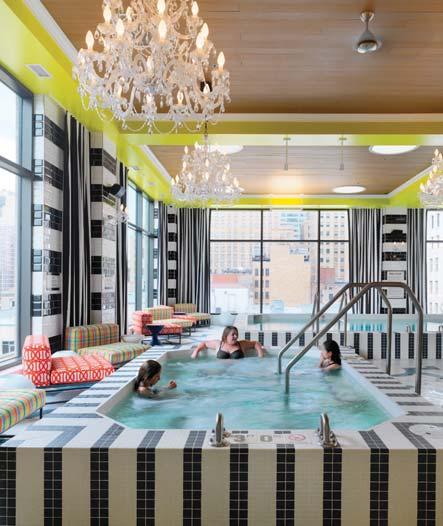
“Taking an office and converting it to residential has inherent complexity to it around all of the systems,” says Markovic. “Typically in a commercial and office building you have your core that runs up the center of the building holding all the restrooms for offices. Getting plumbing out to the further expanses of the building is where that gets challenging. It means being very strategic and utilizing that vertical core to get to each floor with the main
Two of the higher profile offices-to-apartments conversions downtown were the Mercantile Building (opposite page and top left) and City Club (top and above).
LEADING THE WAY
According to a CBRE study, Cincinnati is No. 2 among U.S. cities in coverting office space to housing as a percentage of total office inventory. More than 9 percent of Cincinnati’s office inventory was in the process of being converted to housing as of late 2024.
THE SHAPE OF CONVERSIONS
When vacancies occur in older office buildings, developers and owners face a choice: Reinvest and fill the building back up with tenants or move into the residential game. The building’s shape can impact that decision as well, with rectangular-shaped floors better for apartment conversions.
KEEP THE COMMUNITY IN MIND
No development is an island, says Nick Lingenfelter of PLK Communities, which is leading the Factory 52 mega-project. “The idea is creating services your residents want to use but that are also an asset for the community,” he says, so literally thinking outside the box (of the building) is critical for any conversion concept.
services and then branching out from there, but not reducing overall ceiling heights. So the corridors may get a little bit shorter, but then we want to keep the apartment units open. It’s really about being strategic about how you’re laying out spaces and units.”
Residential spaces have different building codes from office buildings. For City Club, the developers and GBBN had to accommodate both code requirements and historical preservation requirements. There was a single staircase that went all the way up the building, for instance, which didn’t meet code. “We always need two stairways for a building with higher occupancy,” says Markovic. “We looked at adding a stair, but that would have reduced the overall unit count pretty significantly. So what we did—per code, but it hadn’t been done in Ohio before—is design an emergency egress elevator.”
It utilized one of the building’s former elevator shafts and resulted in another part of the existing structure being preserved. “Getting residents out of the building is different from getting people in office or commercial spaces out of the building,” says Markovic. “There are different code requirements, so that’s always the first thing we look at in these older buildings.”
Next door to City Club is the PNC Tower, an apartment conversion now called Sky Central. The former office building remains under construction but will soon add 294 market-rate units. Conversion of the former Pogue’s Department Store building on Race Street by ABC Realty Advisors was announced in 2024 and will add 122 apartments designated as affordable housing, not market-rate, a rare move for downtown real estate.
PLK COMMUNITIES PURchased the former U.S. Playing Card factory after it had been vacant for more than a decade and transformed it into Factory 52, a residential and mixed-use center in Norwood. The company has grown into the largest owner of multifamily housing units in the Cincinnati region over the past 25 years.
“I think just about everybody in town looked at that Norwood site and was looking at it from, How do we restore and rehabilitate the whole thing? And it just didn’t work,”says Nick Lingenfelter, chief development officer of PLK. “We found the only way we could do it is if the city approved us demolishing a significant amount of the structures there in order to make the project economics work.”
Two of the former factory’s most iconic landmarks were the grand old brick clock tower at the front of the complex and a tall smokestack. PLK and MSA Architects knew the community considered these visual touchpoints as important to preserve.
“We thought we could actually incorporate them into the new design,” says Lingenfelter. “When you’re walking the site, one of the things I wanted to do was leave the character and leave the flaws, because so many times when you redevelop an older building it ends up looking brand new when you’re finished. And that’s not really what we want to do. We want the things that people touch the most to be those character points.”
Two other original structures were preserved on the 20.6-acre site: the factory building and the shipping facility. The latter became the public food hall, Gatherall. Residential


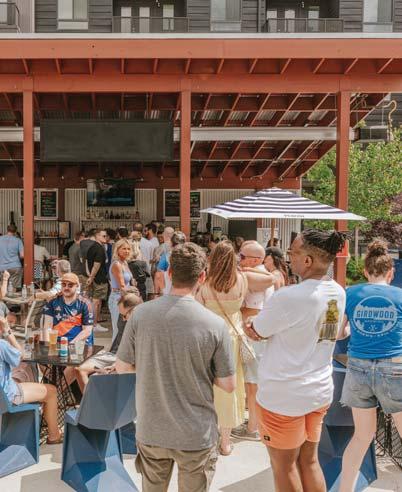

buildings in the complex include the Factory Building, Power Building, Central Green Building, Kenilworth Building, and Kenilworth 2 Building, comprising a total of 442 units. The constraints of converting a factory to

residential space are similar to those of an office building; the floor plate is critical to the conversion success here as well.
“The thing people don’t realize is you don’t typically want a unit more than 35 or 40 feet deep,” says Lingenfelter. “When all of your windows are on one side, it becomes difficult to make sure there’s enough natural light in that living space. Most of our newer buildings are around 6065 feet wide, and some of the Factory 52 units were well over 100 feet wide. So you have to add balconies and do other creative things to make sure the space will work for today’s consumers.”
PLK was able to preserve existing infrastructure for 66 historic units, and the remaining buildings are new construction. Factory 52’s first phase included apartments, the Gatherall, the park space, retail space, the leasing office, the preserved Clock Tower, parking structures, a Braxton Brewing taphouse, and the Astroturfed-central greenspace. The developer had to weigh the needs and desires of apartment residents equally with those of nearby existing residents in Norwood.
“The idea is creating services your residents want to use but that are also an asset for the community,” says Lingenfelter.
To that end, PLK installed the Bark Park, an Astroturfed public dog park (something Norwood didn’t have) on what Lingenfelter called a “funky-shaped” piece of land that was otherwise not in use. “One of our thoughts was, Hey, Factory 52 has breweries, and lots of breweries allow dogs, so how do we create an amenity for everyone in the area that really becomes this kind of public gathering place?” says Lingenfelter. “It’s a hard problem to solve sometimes. Like, Yeah, what’s in it for the neighbors? Well, typically, a developer is improving a property or taking something that was underutilized and bringing it back to life, and that project then improves all the property values around it.”
PLK purchased the Multi-Color Corp. building next to Factory 52 in 2024, along with a vacant lot on Robertson Avenue. Phase 2 is now underway on the Multi-Color site, with plans for 48 townhomes on the Robertson lot; a final timeline is still to be determined.
A MIX OF OLD AND NEW Factory 52 saved iconic parts of the original U.S. Playing Card factory, including its clock tower, and built new housing and amenities around them.
AFTAB
CORY
DISCUSS THEIR TRACK RECORDS AND LEADERSHIP PRIORITIES AHEAD OF CITY ELECTIONS IN NOVEMBER.
BY JOHN FOX
Cincinnati residents will go to the polls on November 4 to elect the next Mayor, City Council members, Cincinnati Public School Board members, and Municipal Judges as well as to decide two tax levies and a charter amendment. The ballot features 26 candidates for the nine council seats and two finalists for Mayor: incumbent Aftab Pureval and challenger Cory Bowman.
Realm interviewed Pureval to discuss the highlights of his first term and explore his priorities for a second term in terms of economic growth, neighborhood business districts, transit-oriented development, railroad sale proceeds, and issues surrounding sustainability, crime, and diversity, equity, and inclusion. We separately interviewed Bowman (page 32) about his campaign issues and his reasons for entering the race. All answers are edited for brevity and clarity.

Economic growth is tied closely to population growth and talent attraction and retention. How can we maintain and improve Cincinnati’s growth momentum?
For the first time in a while, the city actually started gaining population over the last 10 years. It’s because of really two main factors when you look at the data. The first is immigration, and a lot of that is driven by our large corporations and large institutions like Procter & Gamble, Kroger, GE Aerospace, and Cincinnati Children’s, which recruit and retain talent. The second is that, once you move employees or even patients and their families, in the case of Children’s, to Cincinnati, what keeps those people here? Young professionals, in particular, are looking for dense, diverse, walkable communities with good public transportation and good access to the arts. And that’s exactly the kind of neighborhoods this City Council and I are trying to incentivize and build.
When you look at the population growth data, you see that in the past Cincinnati grew because people from smaller communities were moving to big cities. Now people from larger cities are moving to Cincinnati because of our affordability paired with our opportunity. Communities like Northside, Walnut Hills, College Hill, and Over-the-Rhine have been intentional about investing in their neighborhood business districts and investing in housing for all income levels. This activity is both a positive and a challenge. It’s a positive because cities our size are either growing or, frankly, slowly dying, and we’re growing; it’s a challenge because, given the
macro economic conditions in the U.S. and in the world right now, it’s difficult and expensive to build new housing today.
City Council passed “Connected Communities” reforms in 2024 to rewrite the city’s zoning and land-use rules. What are your goals for increasing housing units in the next four years?
In the past 10 years as our population has grown, Cincinnati has actually lost housing on a net basis, so there are more people living here and fewer places for them to live. When I took office in January 2022, there was so much uncertainty resulting from the pandemic, and remote work had threatened to hollow out our downtown. This council and I got to work on our top priorities, public safety and housing, and I think the proof is in the pudding.
300 units of new housing. The Mercantile Building is a similar story. We just passed tax abatements for Carew Tower, which will offer rehabbed commercial space on the first floor and convert all of those floors that used to be offices into housing. And so, today, Cincinnati is actually second in the nation for taking underutilized office space and turning into housing and third in the nation for lowest vacancy rates downtown. If you look at our parking data, there are more people parking in the urban core today
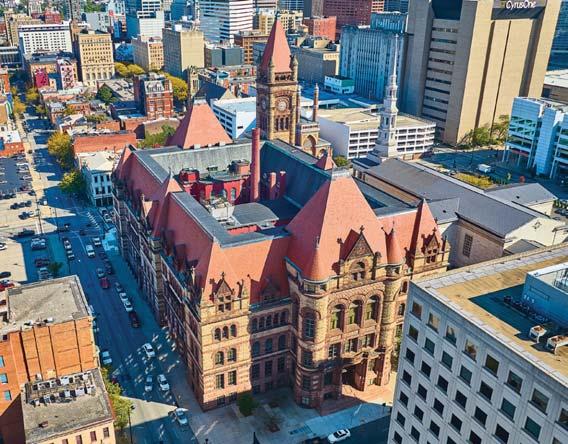
versus pre-pandemic times.
Part of the population growth is tied to our success at creating new housing, particularly in our urban core. We got to work taking underutilized office space and turning it into housing, particularly downtown. So you look at the Macy’s office building, which sat vacant for years before we took office and now has more than
With Connected Communities, we were the first city in Ohio to enact comprehensive zoning reform. It’s a conservative approach to deregulation that allows the market to flourish by legalizing duplexes, triplexes, quads, townhomes, and row homes in our neighborhoods. Those often are starter homes for folks. We were intentional about this program, particularly in neighborhood business districts where we want more housing and more customers for the small busi-
“WE TRIED TO RECRUIT THE SUNDANCE FILM FESTIVAL HERE AND FELL SHORT, BUT WE CONTINUE TO STEP UP TO THE PLATE AND TAKE BIG SWINGS,” SAYS PUREVAL.
nesses and want development along transit lines. We’ve got to continue to be a modern, innovative city, and I think people are looking for a city that invests in public transit and housing and makes hard decisions about zoning in order to accommodate growth.
Not everyone agrees with every decision made at City Hall, but it feels like your plans align with many of the city’s top corporate leaders, the Cincinnati Chamber, tourism leaders, transportation leaders, and education leaders. How can we improve on this collaboration?
That collaboration is special and unique in Cincinnati, and it’s why we have been so successful not just in my term but in the previous years as well. We’re just not a large enough city to have all the resources necessary to do all the big things we want to do. The ideas that actually push the city forward in a transformational way are usually public-private partnerships. We can just start geographically at The Banks, where my predecessors were able to get everyone together to convert surface parking lots and dirt
patches into such a high-performing area. Then they formed 3CDC as a public-private partnership and reimagined the Fountain Square district and Over-the-Rhine. Universal preschool programs were introduced through a public-private partnership. We can do Bus Rapid Transit only because we passed a county sales tax increase. The sale of the railroad to create a $1.6-billion infrastructure fund was a public-private partnership.
And that collaboration, I think, is a key strength of Cincinnati. I took it on personally to restore and strengthen the relationship between the city and the county in order to continue to take big swings. Before I took office, the downtown convention center was languishing. There was no plan for renovating or expanding it and no strong partnership between the city and the county. The city owns the convention center, and the county owns the old Millennium Hotel after spending a lot of money, rightfully so, to get control over it. Because our relationship has been strengthened and restored, we were able to invest $600 million into rehabbing the convention center to make sure Cincinnati is a destination city.
We’ve also cooperated to restart a Regional Sports Commission to help us bring more live events to town. When Taylor Swift came here a couple of summers ago, it was like a $75-million impact over one weekend that really opened my eyes to the potential of those investments but also the dollars we’re losing because we don’t have an organization recruiting the NFL Draft and other large events. Our lunch is being eaten by Indianapolis, Columbus, Louisville, and Nashville because we aren’t out there com-
peting. We competed very hard for the 2026 World Cup, and while we fell short we did host several Club World Cup matches and we’re in the running to be a home base for one of the large international teams. We took a huge swing on the Sundance Film Festival, and while we fell short there as well we continue to put Cincinnati on the map and continue to step up to the plate and take big swings. In order to do that, though, these-public private partnerships are critically important.
You personally went to Sundance, Utah, to lobby festival organizers to select Cincinnati as their new home. What was your takeaway from that experience?
As part of the selection process, a large number of film industry people visited Cincinnati to check out the city firsthand. Some came during BLINK last fall, which was amazing, and others came at random times over the winter. Overall, they seemed impressed at how well everyone works together here, and not just in the arts but across all of the various political entities. I think they were surprised to see Governor Mike DeWine, a Republican, and me, a Democrat, on the same stage having not only a strong professional partnership but also a personal relationship. That really personifies the relationships I take seriously and am intentional about, because I can’t be the very best Mayor for Cincinnati and the city can’t be as strong as it should be unless the Mayor has good working relationships with all of the important stakeholders at the state, regional, and neighborhood levels. That takes work, but it’s important.
A number of cities are doing transit-oriented development around light rail and Bus Rapid Transit. Cincinnati’s first two BRT lines (Hamilton Avenue and Reading Road) are scheduled to debut in 2028. What will the city be doing to prepare to take advantage of those routes in terms of business and population growth?
When I think about how I can influence positive change as Mayor, we invest in programs and organizations and events, but the actual opportunity to make huge and lasting change is when you reform systems. And so we were intentional to push for Bus Rap-
id Transit through our advocacy to the SORTA board and then through how we were changing zoning regulations. One of the routes goes through Roselawn, Bond Hill, and Avondale, and those three neighborhood business districts have been underinvested in for too long.
Our approach is kind of similar to when the streetcar started laying tracks, which became an economic development tool because developers purposefully built or rehabbed along the line. Bus Rapid Transit features fixed routes with real bus stops, not a bench or a sign, and if we can put those bus stops in underinvested neighborhood business districts and then loosen zoning restrictions to make development easier in those areas, we will have organically incentivized investment. In this past bud-
get, we allocated $6.5 million just for Bond Hill neighborhood businesses with no specific project we’re investing in. We’re telling the community that we take Bond Hill seriously. There has’t been enough investment in Bond Hill, so community developers, The Port, and the state should come to the table. We have $6.5 million in a pot to get you started. Let’s come up with a plan and do it.
In a similar way, we changed our budget process so now there are awards for community councils applying to the city to get direct capital funds. Now it’s going to take some time, but when you have community councils, neighborhood redevelopment corporations, and City Hall on the same page, you see the results in places like Walnut Hills, College Hill, and Northside. It takes time, inten-
Metro’s planned Bus Rapid Transit lines will help incentivize neighborhood development, says Pureval.

tionality, and dollars, but our track record over these past several budgets shows you that we take those relationships seriously.
One neighborhood where these good feelings and cooperation are strained right now is Hyde Park, with the controversial housing development on Hyde Park Square being pulled after council approved it. What lessons do you take from that situation?
We tried to support a housing project there, but the controversy wasn’t the fault of Hyde Park. It wasn’t the fault

of the developer, either. It’s all of our fault. We are in a crisis for housing. The city of Cincinnati needs to build 40,000 units over the next 10 years, or 4,000 units per year. Even with all of the effort this council and I have put forth through the Affordable Housing Trust Fund, with over $100 million in it, through rezoning, through investments in the American Dream downpayment initiative, and through subsidies and incentives toward housing, I think we’re on track to build 1,500 units this year. That isn’t enough.
I’m not making excuses for the city, but consider the interest rates, the tariffs, the cost of construction, and everything is harder now because of macroeconomic factors, and we’ve still been able to build 1,500
units of housing. What we’re lacking at this point is the community will that we need housing. We need to be pro-growth-oriented if we’re going to grow our population.
Back to the Sundance conversation, more and more people are realizing that Cincinnati is no longer a best-kept secret. We’re growing our brand. I believe we’re on the precipice of a real golden age in Cincinnati. The only thing that may hold it back is our collective commitment. If Cincinnati becomes known as a city that’s no longer affordable, not just for our legacy residents but for new residents, then we will stop growing and will start going backwards.
You can kind of work almost anywhere now, so young professionals in
You’ve not held office before. What inspired you to run for Mayor?
My initial thought was just, How can I play a role in helping people in our city? I’m a pastor and a coffee shop owner, so I thought I’d just be more vocal about things and help support candidates or other people who were helping. But when I saw the need for a candidate
for Mayor, I stepped in.
If you’re running a nonprofit or running a business, you have to have some kind of knowledge of administration. When I look at city politics, a lot of people are trying to jump on board national politics and national issues, but people want low crime rates, their potholes and streets fixed, and funds to be spent properly. Even
though it seems like an oversimplification of the job, that’s what’s needed. I can make sure the city runs to the best of its ability.
Do you feel like working so closely with the community at your Kings Arms Coffee in the West End gives you a good read on the pulse of the city? Absolutely, because I find that many peo-
ple jump into these races and expect votes from people they don’t have a relationship with. We’ve been pastoring in the West End for five years and have had a front-row seat to city policies that are failing the communities. We’ve experienced things that are hindering growth and prosperity in our communities, and a lot of it has to do with
particular are more mobile than ever. Why not live in a place where you can buy a house for half the price you could buy it for somewhere else?
The sale of the city’s railroad line created a trust fund to pay the city more money per year than the old lease arrangement. The first money from that fund is flowing into the city as we speak. What are your plans for this new non-tax revenue?
Investments from the $1.6 billion railroad trust fund generated $56 million for the city this year without touching the principal, and we expect
this year’s amount to be similar. (After this interview, it was announced that the 2026 payment would be $58 million.) When I took office in 2022, the railroad wasn’t on my radar. I don’t think it was on anyone’s radar. But the timing was perfect, because the 20-year lease expired the year I took office, and it became my issue to solve. I give the city’s railroad board a lot of credit, because they negotiated hard with Norfolk Southern and came to a fair market value that both parties could accept. Creating a new fund that will be there in perpetuity for the sole purpose of maintaining our existing infrastructure is a game-changer. In the last year of the Norfolk South -
“I’M A PASTOR AND A COFFEE SHOP OWNER,” SAYS BOWMAN. “BUT WHEN I SAW THE NEED FOR A CANDIDATE FOR MAYOR, I STEPPED IN TO LAUNCH A CAMPAIGN.”
ern lease, the city got $25 million; we got $56 million in the fund’s first dispursement, more than double. For anyone concerned about the fund’s long-term viability, it’s directly tied to the long-term health of the U.S. economy. I mean, if the fund is im-
policies from the top down.
What are your top campaign issues?
What is your plan for economic and housing growth in Cincinnati?
To help the people that need to be helped, but to also help to get them out of bad situations. Current programs keep people in pov-
Budget, crime, and infrastructure. Potholes are everywhere, and snow removal basically was nonexistent during the winter months. We’re not seeing a properly run city when it comes to combating crime in our city. And then budget funds are not going where they need to go. A lot of funds go toward nonprofits, NGOs, or community initiatives that do not affect the communities like they say they do. And so there needs to be a complete audit and complete transparency on how these funds are being spent.
erty, and there’s no pathway forward. In the West End, you have affordable housing units and then you have an $800,000 townhome. There are no policies that are bringing jobs to Cincinnati. There are no jobs. I believe we need to incentivize revamping our historic buildings. There are so many vacant properties, but a lot of them are held on the books by nonprofits and NGOs funded by the city. And whenever de-
What needs to change at City Hall in order to reduce crime?
You have a city manager’s office that’s proven time and time again they’re incompetent in managing our city, and then that city manager appoints the police chief, and the police chief and the admin-
velopers reach out to these organizations saying, Hey, we want to make this into a local business. We want to have a grocery store here. We want to have studio apartments, a lot of times it takes years of red tape to even get to a point where they can consider it, and then by the end they realize the model isn’t incentivized for them to be profitable. There’s so much historic value in our empty buildings, and if we incentivize reconstruction and revamping of them and provide adequate housing for people trying to have that pathway out of poverty, that’s the smartest approach.
istration behind the chief have shown they’re not ready for the task of protecting our city. I would put pressure on judges and prosecutors not to release arrested criminals back onto the streets, and if they fail to do so I’ll have a weekly live stream or a press conference where I publicly state what judges released what criminals every week until the criminals are receiving sentences that they deserve.
The police officers that come in my coffee shop almost on a daily basis overwhelmingly disapprove of how things are being run. They don’t believe City Hall has their back. The cops say, If we arrest somebody, that person is going to be on the street next week because of the lax judges or the prosecutor’s office. So in reality, you’ve demoralized the police force.
—EMMA BALCOM
GROW OR DIE
Running for re-election, Aftab Pureval says population growth is key to economic growth, but housing shortages may inhibit Cincinnati’s future growth. He’s embraced the city’s goal to build 40,000 new housing units over the next 10 years.
COLLABORATION IS KING
Pureval says successful big-city Mayors are far more pragmatic than they are partisan, which is why he seeks out partnerships with Governor Mike DeWine, corporate leaders, neighborhood councils, and development groups.
Challenger Cory Bowman says his campaign is focused on improving budget transparency, reducing crime, and battling infrastructure shortcomings in road paving and snow removal. He’d prefer to increase housing by prioritizing vacant historic buildings over new units.
pacted negatively by the U.S. economy, we have bigger problems, right?
We’ve doubled the amount of dollars we put into road-paving, because potholes are important to people, and when you pave a road it’s impervious to potholes for five years. So we’ll catch up on our backlog over time. When I took office the city had a $400 million deferred capital maintenance bill. We couldn’t afford to maintain the infrastructure we had, and so outside of raising taxes we were potentially in a position where, if that deficit continued to grow, the deficit could be greater than the infrastructure’s actual value. So something significant had to change.
We presented a six-year plan in our last budget showing that we’ll spend the money on roads, bridges, fire stations, parks, and rec centers. I understand that the sale was controversial, because any time you sell an asset there’s risk. But we did the hard work in collaboration with the state legislature to say this money would be narrowly targeted only on existing infrastructure in order to prevent any political chicanery from happening.
If you win re-election, your next term will end right before 2030 and the city’s deadline for meeting goals put forth in the 2030 Green Cincinnati Plan. Where do you think we are in terms of hitting those sustainability goals?
We’re right on target. Our carbon emissions continue to go down. I think
over the last year we’ve purchased 19 electric vehicles. Mayor John Cranley deserves credit for building the largest municipal-led solar farm in the country, and we’d like to expand that effort to the former Center Hill dump in Winton Hills. It’s basically unusable land because of brownfield remediation, but we can turn it into another solar farm to increase power-generating capacity.
We continue to have our foot on the pedal with respect to climate
“FROM THE VERY BEGINNING OF OUR CITY, DIVERSITY AND INCLUSION HAVE BEEN PART OF OUR DNA. IT’S DEEP IN OUR BONE MARROW,” SAYS PUREVAL.
change and mitigation, but on the other hand climate change will have an impact on our city. The reason Intel chose central Ohio for its huge investment, just two hours north of here, was because this region is climate resilient and has access to fresh water. Large businesses are going to continue to make capital investments and employee investments based on those two factors. That’s such a long-term play, obviously, to think about where we might be 20 or 30 years from now, but part of why I love my job is because no other person in our government is thinking on a 25-year horizon. Given all of the uncertainty and chaos in the world, the cities that are innovative and risk-tolerant and take big swings are the cities that are going to really
succeed over the next 25 years.
You openly endorse diversity, equity, and inclusion, which has become a political football. Where do you stand on celebrating and encouraging these concepts in Cincinnati?
I want to be very clear that my diversity, equity, and inclusion beliefs are central to my role as Mayor. We want to celebrate it, of course, but more than anything we want to invest in it for the simple fact that there’s huge wealth inequality in Cincinnati having a profound impact on everything from home ownership to health outcomes. Where you were born in the city, just your neighborhood, has a huge impact on the kind of educational opportunities you’ll have, the kind of career opportunities you’ll have, and even how long you will live. So our equity and inclusion strategies are meant specifically to even the playing field—not as it relates to results, but as it relates to opportunity.
As long as I am Mayor, Cincinnati will continue to lead with those values. From the very beginning of our city, diversity and inclusion have been part of our DNA. It’s deep in our bone marrow. Cincinnati was the destination for the Underground Railroad, home to Harriet Beecher Stowe, the Mapplethorpe exhibit, the collaborative agreement on policing. Even when gay marriage was decided by the Supreme Court, it began with Jim Obergefell’s lawsuit in a downtown courthouse here in Cincinnati.
There’s been a lot of conversation about crime across the
city, especially in the urban core. Perception often supplants reality. What is the reality?
Cincinnati is one of the safest major cities in the country, but it can and needs to be safer. Frankly, the data doesn’t matter as part of the conversation any more. What matters is how people feel, and too many people feel that Cincinnati is unsafe. I will caution that that isn’t true for everybody, because thousands of people have continued to come downtown and explore and really enjoy our city. But too many people don’t feel safe, and so we’ve been incredibly ambitious and aggressive to increase our visibility investments in the urban core, beginning at The Banks and going north through the night every single weekend. We now have bike patrols in the Fountain Square district area and walking patrols for the first time in a long time on Main Street, Vine Street, and Court Street. On the enforcement side, we’ve also empowered our police officers to enforce the law as it’s written.

asked them to do so much above and beyond what we usually ask them to do. And every single time they’ve answered the call.
At some point soon we’ll have to transition into a winter strategy, but certainly as long as it’s warm we will have police officers visible in the downtown area. In winter we may not have walking patrols just based on the weather, but we’ll likely maintain some kind of visibility strategy in the urban core.
We also deepened our partnership with the governor to have greater bandwidth to send highway patrol officers to Cincinnati and support the men and women in our police department. So we take perception very seriously. Public safety is something you have to consistently stay on top of. The work that Cincinnati Police do is extraordinary, and we’ve
Again, it’s all about collaboration. The most successful Mayors in the country are far more pragmatic than they are partisan. If I treated P&G the way Florida Governor DeSantis treated Disney, I’d get recalled the very next day. There’s just no patience for that in local government, specifically from the Mayor. And so whether it’s partnering with Governor DeWine on public safety or partnering with corporate leaders on economic development, what’s most important to me are the relationships and the collaboration.

HERE ARE FOUR UNIQUE STORIES BEHIND CINCINNATI’S BOOMING MANUFACTURING SECTOR.
BY ALEXANDRA FROST
Their products are in a lot of things you use, but you might not know it. Cincinnati’s manufacturing industry runs on our need for everyday items and products to function seamlessly, from the handle on your gas pump to the panels holding the lighting above you as you read this issue of Realm
Not all manufacturers are the same, of course. But even if their company cultures or product lines vary, local manufacturing leaders share the same passion for the community they serve. And that commitment to Cincinnati has never been more apparent than in the local industry’s upward trajectory—even as national trends show the opposite, with 42,000 layoffs in manufacturing across the U.S since April.
Cincinnati is succeeding in the face of national downward trends partially due to GE Aerospace and CVG/Amazon attracting new vendors and suppliers to the region—companies that might make one single part for jet engines but create large factories that employ hundreds. And the heart of some
of these small companies derives from their multi-generational structures. They’ve seen ups and downs in the economy over many decades and, in some cases, centuries.
Here are four smaller manufacturers in the region you might not be familiar with, but they’ll teach you a thing or two about resilience.
What’s in a name? Quite a bit, it turns out, for this Madisonville-based manufacturing company established in 1979. Founder Joe Gutierrez, whose father was a Castro-era Cuban immigrant, christened the business Aire, which is Spanish for “air.”
Gutierrez was a University of Cin-
cinnati graduate and did what founders do to make it work: Put himself last at first. “In the beginning, Joe along with partners Lenny Depenbrock (and eventually son Dana), Tim Kidd, and David Miller sacrificed earnings to build a business from the ground up,” says Airecon President Josh Jacobs. “And then they turned new customers into loyal customers. The partnerships they created are still strong today.”
As with many local manufacturing businesses, the founders focused in the early years on key differentiators and distinguishers. In Airecon’s case, Jacobs says, “Airecon was founded on the principle of being hyper-focused on the customer’s process to deliver custom, reliable, and high-quality industrial ventilation systems and metal products. The approach was adopted to


Steinhauser CEO Tara Halpin says connections across the region help all manufacurers.
‘Discover the Airecon Difference.’ They understood that they needed to help customers grow and asked what they could do as engineers, skilled tradesmen, and contractors to make a difference.”
Airecon builds control systems and equipment to handle industrial dust, fumes, mist, and scrap metal as well as an array of custom industrial metal products such as tanks, totes, bins, carts, hoppers, platforms, and chutes in a variety of classifications, including foodgrade stainless steel. Manufacturing partnerships can be key to success, says Jacobs, as not every company is able to make every product required by a customer. Airecon partners with the some of the best-known equipment manufacturers in the world, including Donaldson Torit, IEP Technologies, and New York Blower.
Jacobs calls the Cincinnati region a manufacturing hotbed with strengths in food, flavorings, materials, metals, automotive, pharmaceuticals, paper, pigments, and aerospace. Part of the region’s “secret sauce” is the collective focus on training both specialists and support staff. “We employ extremely talented sheet metal workers, which allows us to provide high quality and diverse metal fabrications that adhere to SMACNA standards,” he says.
Simply hiring an exceptional team isn’t enough, though. Companies must also create an environment to retain, grow, and protect their workers. “A wise person once told us, Hope is a poor strategy,” says Jacobs. “Mottos aside, we all have hopes and dreams, but it’s more about how we achieve them. It’s investing in our employees and facilities. We value high retention and a safe workplace that empowers our team to solve problems together. We strongly believe the grass is greener where you water it.”
Airecon has experiened “tremendous horizontal and vertical growth” over the

last 10 years, says Jacobs, and he expects significant growth in the next five to 10 years. “We employ, partner with, and serve a one-of-a-kind community,” he says. “We don’t take this success for granted.”
Cincinnati is rich in legacy businesses, where manufacturing leaders pass down their enterprise from one generation to the next. That was the plan with Albert Steinhauser, who founded a commercial printing company in his garage in 1905. His son Harold was slated to take over the family business until he was tragically killed in World War II, so another son, Wilbur,
stepped up in his absence, ultimately building the company into what it is today.
Albert’s initial customer service mission might remain the same across the span of a century, but the “how” morphed with technology and leadership changes. When Wilbur took over in 1945, he launched the company into the label market and self-mailers while driving growth through creative marketing initiatives, says Tara Halpin, Steinhauser CEO and owner. The family passed the torch again in 1977, when Wibur’s son Robert Steinhauser was named president and the business relocated to Newport. His priorities deepened customer relationships, upheld a culture of integrity, and pushed
for innovation, she says.
As Robert’s daughter, Halpin became president in 2005, and she and her brother, Trevor Steinhauser, bought the company two years later. They decided to sell the commercial printing business to focus specifically on labels, a niche they built with just a single customer. Today the company offers printing support for beverage, household, personal care, and spirits companies such as Poo-Pourri, Mr. Clean, Dawn, Swiffer, and The Kind. Halpin became CEO and sole owner in 2018 and has focused on staying independent and making the best company decisions confidently and quickly. “What makes Steinhauser unique is that we’re one of the few
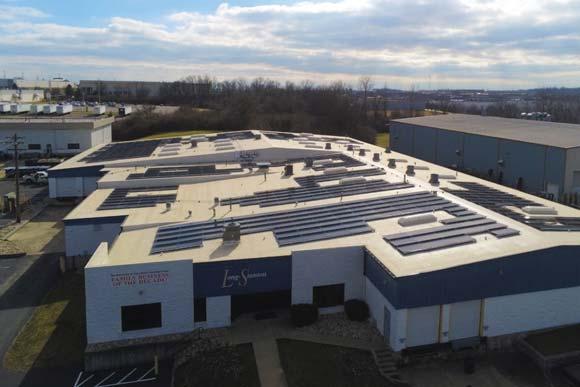
woman-owned, family-owned, and independently-owned companies of our size in the custom label printing industry,” she says. “That independence allows us to serve our customers in ways our competitors can’t. We gain alignment easily and stay fully focused on our customers and their brands.”
Halpin says there are many bene-
fits the company enjoys being headquartered in the region. “Cincinnati in general is an affordable place to live with lots of safe neighborhoods, making it easy to find qualified employees,” she says. “There’s a robust supply chain with resources to support you, and the airport makes us easily accessible. Newport itself is incredibly
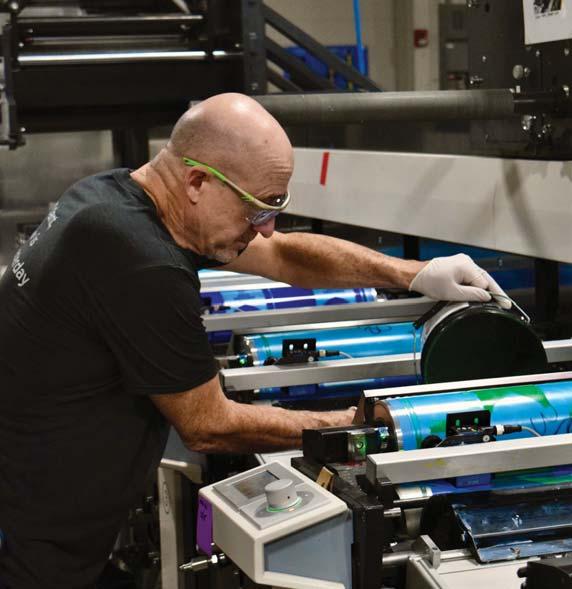
walkable for employees and customers alike. The community is tight-knit, allowing us to develop relationships with other local government and businesses.”
Key partnerships have included BE NKY Growth Partnership, which helped Steinhauser connect with leaders in Newport government. Halpin is hoping to soon expand connections with local schools, from middle school through the university level, to educate young people on the manufacturing industry’s potential and to provide co-ops and internships for career development.
In 1835, when Cincinnati was known as “Queen of the West” and the country’s largest inland city, manufacturing was booming. John Stanton became an apprentice at Ira Bisbee’s steel brand and stencil-cutting business, founded by Ira’s father Ziba, and together they produced tokens for politicians and, during the Civil War, fractional legal tender called “store cards,” which acted as a form of currency and helped businesses advertise their services.
Stanton eventually took over the downtown-based company and rechristened it Long-Stanton, the name it still goes by six generations later. “I have a full-size shape of Abraham Lincoln’s profile that we produced, a thin tin type of metal stamped out in his profile and painted,” says President Marvin Cunningham. “Back in the day, people used to have that kind of stuff hanging in their house.”
Fast forward a century, and the company made an essential stamped-metal part used in Easy Bake ovens. The next time you’re
HANDS ON Manufacturing is humming along at Airecon (opposite page), Long-Stanton (above), Steinhauser (below), and lots of other locations across the region.
LOCAL GAINS IN MANUFACTURING
Cincinnati is bucking the national trend by adding manufacturing jobs while, overall, U.S. manufacturers have laid off 42,000 workers since April.
FOCUS ON TRAINING
Airecon’s Josh Jacobs calls the Cincinnati region a manufacturing hotbed with strengths in food, flavorings, materials, metals, automotive, pharmaceuticals, paper, pigments, and aerospace. Part of the region’s “secret sauce” is the collective focus on training both specialists and support staff.
THE REGION’S BENEFITS
The Cincinnati region is affordable place with lots of safe neighborhoods, “making it easy to find qualified employees,” says Tara Halpin. “There’s a robust supply chain with resources to support you, and the airport makes us easily accessible.”
at Arnold’s Bar & Grill downtown, Cunningham says, look across Eighth Street to the parking lot where a small factory could barely keep up with mass consumer interest in the product. “All of a sudden we were running seven days a week, multiple shifts,” he says. “They would deliver steel on Monday, and by Sunday afternoon there was no more space. Then we’d start all over again. That took us from a small company to a larger one over 20 years, until the Easy Bake ovens switched to plastic components.”
In the 1960s and ’70s, Long-Stanton turned to nozzles on gas tank pumps. In the ’80s and ’90s it was air compressors, and the turn of the century brought a focus on aviation such as airplane brake parts. Today, says Cunningham, the West Chester-based company is responsible for lots of “odds and ends,” or necessary parts that are “buried inside an assembly that nobody thinks about.”
The company is a minor player in the larger geopolitcal buffeting tied to tariffs and trade agreements. Cunningham says he helped establish a Long-Stanton manufacturing facility in China in the early 2000s, but the work came back to this region five years later—as is the case with a number of his manufacturing customers. “A lot of stuff that’s easy to reshore has been reshored,” he says. “Some of our customers have moved their operations south, especially to areas like the Carolinas and Virginia. I think they did that to try to save a bit on labor and not have to move to Asia.”
Running a company with nearly two centuries of history is a “blessing and a curse,” says Cunningham, who took over the president role from his
father. “There’s an immediate trust you don’t necessarily get with a company that’s been around for five years, because customers know we aren’t going to disappear tomorrow,” he says. “At the same time, starting with a blank piece of paper would be really nice sometimes.”
Cunningham hesitates to refer to himself as “president,” remembering his childhood when he’d ride machines on the laps of some of the workers who are still at Long-Stanton and whose
“WHEN YOU TELL PEOPLE YOUR BUSINESS IS 155 YEARS OLD, A SENSE OF TRUST COMES WITH THAT,” SAYS ARTIE SCHALLER AT NATIONAL FLAG COMPANY.
families have served the company for multiple generations. He says he can’t imagine corporate life at a Fortune 500 firm with constant meetings; his employees meet once a month. “We’d rather just spend our time making the stuff,” he says. “We have 30 people on staff and more machines than people.”
Even with the small staff, the company is able to offer customers lots of manufacturing and shipping flexibility. For example, says Cunnignham, if he’s producing an order with multiple items, Long-Stanton will offer to store them and deliver them quarterly so the customer can buy three years’ worth of inventory at a time. “Now they’ll be slightly more expensive because Na-
tional Flag’s business niche is flags and other products hand-sewn in the West End by talented craftspeople. holding them,” he says, but not as expensive as some other options. “Everyone’s happy. I’m interested in those kinds of winwins with our customers.”
He recommends that business owners focus on networking to “not let their bubbles get too small” and get to know five people in different industries who you can reach out to whenever you need help or advice. “We’re not making anything top secret. We’re just trying to give all of our employees a comfortable life and stay open another 100 or 200 years.”
There aren’t many hand-produced products that people pledge allegiance to on a daily basis—at least not in Cincinnati. The owners of National Flag, however, understand that
they’ve been cut from a different cloth since the company’s founding in 1869.
Current company owner Arthur (Artie) Schaller III started out sweeping floors, folding flags, and cutting material at age 14. “My first paycheck was for $18 and some change,” he says. “I remember having my own money to buy candy at concession stands. Seemed like a big win at the time.”
After taking over for his father in 2021, Schaller says his employees are bringing home much larger paychecks but remain commiteed to authentic craftsmanship in the face of evolving technology. “We’re one of a few companies in the U.S. producing fully-sewn custom flags and banners,” he says. “We do offer printed options, but our niche in the industry is custom appliqué and embroidery work. Custom products are still stitched by talented seamstresses and put together with scissors, yardsticks, and safety pins. Nothing automated.”
Schaller understands that each

American flag his West End-based company embodies freedom, pride, unity, and hope for customers. He also recognizes that often the product is displayed out in the elements and will fray and tear over time and needs to be replaced. “So flag quality is a big deal,” he says. “Standard flags last eight to 10 months, but Mother Nature is always unpredictable.”
Business is good these days for National Flag, as American-made products are making a slight comeback, he says, even before tariffs were implemented. “Our biggest challenge has been overseas options and pricing since the dot-com era,” says Schaller. “Anyone can open an Amazon store and say their flags are USA-made. Whether that’s true or not is a different story.”
Social media has played an integral part in helping the company demonstrate and communicate its dedication to craftsmanship. “We can show exactly where a flag is being made, how it’s being made, and by who,” he says. “Customers can see where their money is going. When you tell people the business is 155 years old, a sense of trust comes with that as well.”
As the country readies to celebrate the 250th anniversary of the signing of the Declaration of Independence next year, the flag industry is preparing for increased sales on all things red, white, and blue, Schaller says. The last time he saw interest like this right after September 11, 2001. “We sold out of everything related to American flag items in a couple days and weren’t able to keep an inventory for another three months,” he recalls.
He offers some well-earned advice to those planning a parade, fireworks show, or any patriotic celebration in 2026: “Get your flag and decoration order in as soon as possible.”
National Flag’s business niche is flags and other products handsewn in the West End by talented craftspeople.
BY DAVID HOLTHAUS
Samuel Adams Boston Lager made its debut 40 years ago at a few dozen bars and restaurants in Boston’s downtown and Back Bay areas. Its founder was a 35-year-old Cincinnati native who’d grown up in Mt. Lookout, graduated from Indian Hill High School, went to Harvard and got a law degree, and left a budding career as a management consultant to follow in his family’s footsteps in the beermaking industry.
Today, the company Jim Koch launched, Boston Beer Company, is a $2 billion publicly traded enterprise, and he’s considered a founding father of American craft beer, which has grown into a $29 billion industry.
Boston Beer has deep roots in Cincinnati. Brewing goes back four generations in the Koch family, and Jim’s paternal ancestors worked as brewers in the city’s 19th and 20th century brewing heyday. Company legend has it that his great-great grandfather’s recipe for Louis Koch Lager, discovered in the old man’s attic, was the foundation for Boston Lager, the beer that launched Sam Adams and Boston Beer as national names.

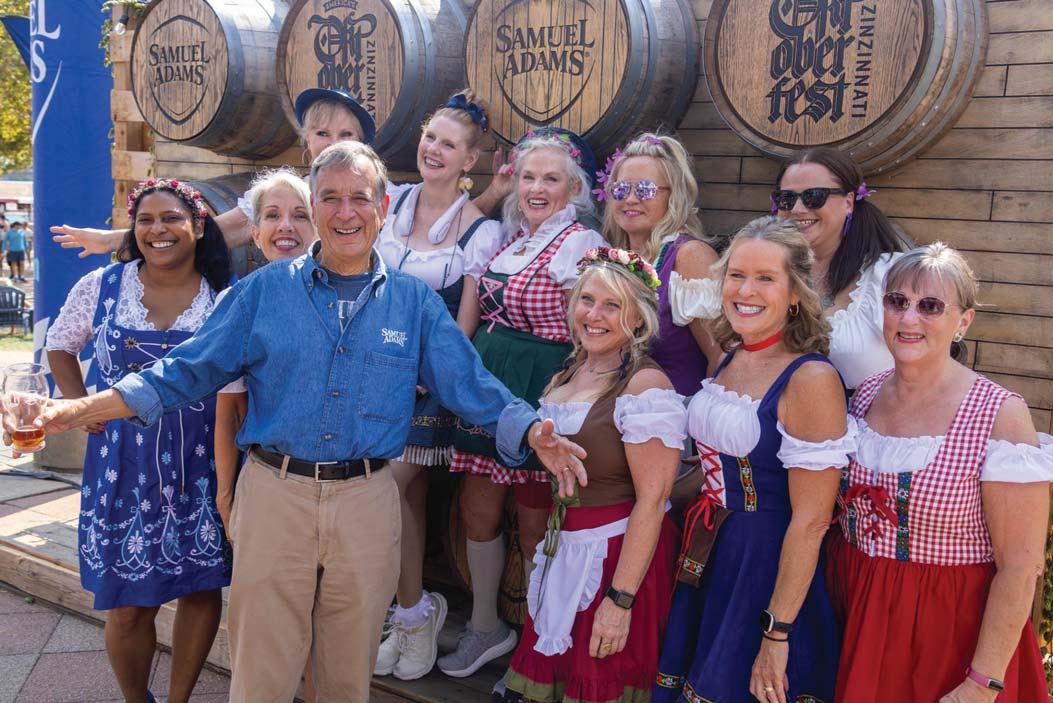
In 1997, as the company grew, Koch returned to his hometown and bought the former Hudepohl-Schoenling brewery, where his father worked in the 1940s. Boston Beer invested $100 million in that West End facility in 2020, quadrupling production with more canning lines and packing equipment to support the company’s growing lineup of brands. The company recently purchased additional property in the neighborhood that it will convert to a tractor-trailer staging area to be used for distribution. Boston Beer now employs about 350 people here.
While Sam Adams lager remains its signature product, Boston Beer has expanded its stable of brands beyond beer. Beverage innovations include Twisted Tea hard iced tea, Angry Orchard hard cider, Truly hard seltzer, Sun Cruiser iced tea and vodka, and Hard Mountain Dew.
In August, the company an-
nounced that Koch would re-assume the title of chief executive officer upon the departure of its previous CEO. He now adds that role to his list of titles: founder, brewer, and chairman of the board.
Koch’s family still owns a farm in Brown County, and Sam Adams has been the presenting sponsor of Oktoberfest Zinzinnati for many years. Koch comes to town each year to tap a ceremonial keg that kicks off the fourday riverfront festival.
Realm interviewed him about his Cincinnati connections, the history of the company, its growth and innovation, and the state of the craft beer business today. Here’s the conversation, edited for brevity and clarity.
You started Boston Beer at age 35. How did that idea come to you?
My father was a brewer, as were my grandfather and great grandfather and great-great grandfather. So beer was in my blood. I guess about .04 percent, so I was legal to operate machinery. But it wasn’t a very promising field to go into as a brewer, so I never really considered it, and I went off to college and graduate school, went to law school and business school, and was in Boston working for consulting company.
I was traveling all the time, and I had two kids. It was really hard on my family, and my wife wanted me to quit. She basically said, “If you don’t quit, I’m leaving.” She left anyway, but I did quit, though I didn’t want to work for a big company like my clients were—that wasn’t an environment I wanted to be inside. Big companies didn’t seem to be a place for the prosperity of the human spirit. They did lots of things well, but it was hard to put your heart into it and really get
HOLD MY BEER
Jim Koch was in Cincinnati on September 18 to help kick off Oktoberfest Zinzinnati, as he does every year.
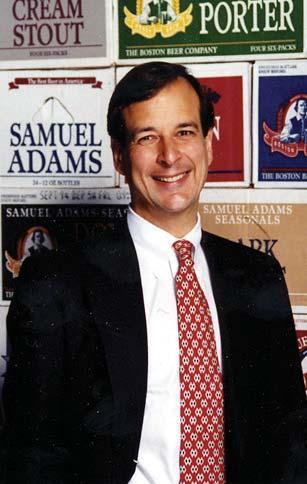
After getting a law degree at Harvard University, Jim Koch worked as a business consultant in Boston until deciding that his heart was actually in making beer.
excited about work.
So I thought about what I could do with the rest of my life that would be cool and fulfilling, and the idea of starting a small brewery was very appealing to me partly because of my family background. I also had some familiarity with the brewing process because I’d been a home brewer.
Craft beer really wasn’t much of a business sector back in 1984.
There were other businesses I considered, but I kept coming back to beer. At that point, there were maybe 10 microbreweries in the U.S. I think there was maybe one east of the Mis-
sissippi, in Albany, New York, and they’ve since gone out of business. So it was the very, very early days, and the unconventionality of it all appealed to me. But who wouldn’t want to make beer for a living, right? Even to this day, when people ask me what I do for work and I say I make beer, it always puts a smile on their face and on mine.
I got to work making it happen. I raised $140,000 from friends and family, and I had $100,000 in savings. So the investment was about what it would have taken to start a chili parlor.
You recently re-assumed the role of CEO. Has this move changed your life?
No, because I’ve been executive chairman and founder, so it’s not like I went away and came back. I wouldn’t have done it if it was going to change my life. There’s nothing I’m doing as CEO that I haven’t been doing for 40 years, but CEO is not the role I wanted to assume.
I’m not an especially good manager. I don’t like a lot of details and process. I’m not good at that. I have a short attention span. I’m not good at follow-up. You may not get your performance review if you report to me, and there are a bunch of things you do as CEO that come with the role that you have to do.
A lot of those you can hand off to your senior management team, right?
Right. The CEO has to sit on the benefits committee, and I don’t want to sit on the benefits committee. I have to sign contracts if they’re over a certain amount of money. I don’t want to read contracts. I have a law degree, which
makes me absolutely sure I don’t want to read contracts. I’m in the process of shedding as much of that clutter and focusing on the essence of the job, creating the culture of being the company leader, of driving the big rocks that are going to make us successful. At looking around corners and over horizons. That’s not just my role as a CEO, but as the founder.
How do the Cincinnati operations fit into the Boston Beer Company’s big picture?
The Cincinnati brewery is one of our two major breweries. We have our original brewery in Boston, which is in the middle of the city. So it was not a place that, as the company grew, could expand very much without becoming a really bad neighbor and bringing in 40 trucks a day through little city streets. It wasn’t practical to build that out. Our brewery in Cincinnati was the first one we acquired. The Boston brewery is really our innovation and experimentation site for very small batches. Then, as we scale up, production goes to Cincinnati or our brewery in Pennsylvania.
Why was Cincinnati chosen for a significant expansion of the operation in 2020?
Cincinnati has always had that German tradition of a high-quality workforce who come to work every day to do work they’re proud of. About five or six years ago, we were kind of at a watershed. Our business had grown a lot, and we needed more capacity. The Cincinnati brewery, in this day and age, is not a place where you add capacity. You typically would find a greenfield site right off the interstate
where there’s a nonurban workforce and you don’t have to deal with the city problems, like trying to get trucks in and out of congested areas. You would have plenty of space, big parking lots, all that stuff.
It was a $100 million investment decision, and my board questioned my sanity. Like, Why would you invest that in such a difficult environment? It’s in the middle of the city, it’s crowded, it’s not necessarily safe, and you got all these Teamsters.
I had to explain to them that, yes, it might be a difficult environment, but the mayor at
the time, John Cranley, said, “Look, I’ll help you, but we don’t have much money to give you.” I said, “That’s OK, what I may need is some help with permitting and those kinds of things. I won’t call you unless I really need it and it’s an easy ask.” Then the whole project was stopped because we couldn’t get a permit to open a parking lot we needed for construction workers because there was some zoning rule about the height of the fence. I called the city and said, “We need a zoning variance. Can you see if you can get the zoning board to meet on this on Wednesday and not in six weeks?” As a business person, you don’t necessarily have your hand out for money. What may be more valuable is just somebody who can make good business decisions on the be-
half of the city and not spend two months trying to do it.
We talked to the union leadership. They knew that if we didn’t invest in the facility their jobs were going to go away. They worked with us on making sure it would be a good decision and gave us a seven-year contract. It’s a pain in the ass for everybody negotiating union contracts, not because of the content but because in preparation for it you’ve got to fill warehouses with product for your wholesalers in case there’s a strike. It’s very disruptive, and then when you settle you’ve got all this prod-
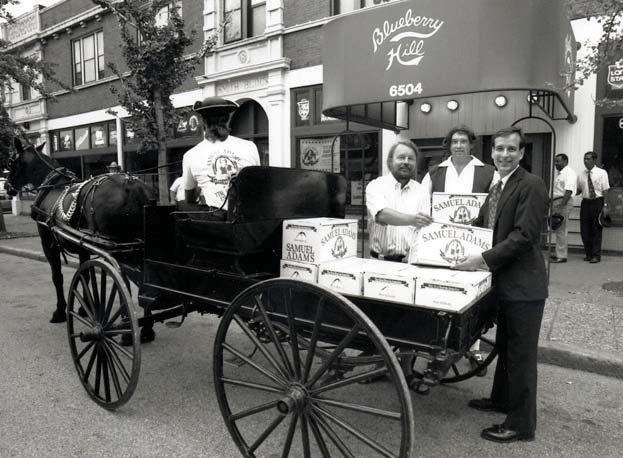
CINCINNATI TRADITIONS
Brewing goes back four generations in the Koch family. Legend has it that Jim Koch’s great-great grandfather’s recipe for Louis Koch Lager was the foundation for Boston Lager, the beer that launched Sam Adams and Boston Beer as national brands.
EXPANSION ON TAP
Boston Beer Co. is expanding its West End presence by adding more distribution space, after investing $100 million there in 2020 to quadruple production capacity.
“THE STATUS QUO SUCKS”
Koch says the craft beer industry, like every business sector, needs to focus on innovation in product lines and customer service. “We can’t just show up and assume people are going to drink our beer,” he says.
uct and everybody’s ready to come back to work. So we were able to work cooperatively and constructively with the workforce. I convinced the board that we had a great workforce there and, sure, we could go out three counties over, but we weren’t going to duplicate those workers. Cincinnati, to me, had these intangibles I valued. So I had to tell the board, “Trust me.”
Boston Beer has been an innovative company. Can you tell me a little bit about how you built that culture?
Innovation is not a separate activity, it’s part of how we look at the world. It’s part of our fundamental motivations and is embedded in our culture. One of our values is “The status quo sucks,” and our mentality is the status quo only exists because we haven’t had yet an opportunity to improve it or just haven’t found or taken advantage of the right opportunity. Innovation is not just new products—it’s, for example, new ways of doing business. Before I started Boston Beer Company, I was a manufacturing consultant, which I did for seven years. It was an exciting time then, because the Toyota production system, the lean manufacturing system, was just revealing itself, offering new principles about how you make things.
How do those concepts work in beer-making?
Equipment makers have not been very forward looking, for one. There are opportunities to rethink how we make beer that comes from our craft roots. One of them is, in the old mentality, long runs were considered efficient. But in lean manufacturing, short runs are the key to efficiencies because they get rid of inventory. If there are defects, you find them really quickly.
Some of these concepts flip the script. In old manufacturing, the more you treat your people like robots, the more productive they are. But the opposite is actually true: The more you can
engage them in the process, the more productive and efficient they’ll be.
Where do you see the craft beer industry today?
American beer was a joke in most people’s minds 30 years ago. If you wanted good beer, you were drinking imports. People would say American beer could float on water because it’s so thin and light, like the foam is on the bottom. Today, the best beer in the world is made by American craft brewers. The quality of our beer is respected everywhere, and we’re the innovators in the beer world. The rest of the world looks to American craft brewers for innovation.
Today, the United States is the best place in the world to be a beer drinker. You get higher quality and more variety. Virtually every style of beer is made at its highest quality in the United States. It might have originated in Belgium or Germany, but it finds its flowering and its best representation here. I imagined such a thing, but only in my wildest dreams. And it came true. There was almost 40 years of growth, and now there are 10,000 craft brewers.
Has the craft beer market hit a plateau?
There is a little bit of angst that we’re not really growing anymore. My response to my fellow craft brewers when I give talks is, Yes, that’s true, we are a mature industry. Guess what? That’s what success looks like. We are an enduring, permanent part of the American beer landscape. Do you have any idea how hard it was to make that happen, guys? That’s what success looks like.
What that means is we can’t just show up and assume people are going to drink our beer. They have lots of choices. Now we have to compete. We have to push ourselves to be better. We have to be sound business people and be centered around serving our customers and innovating to create cool, new things. But that’s every business in the world, right?































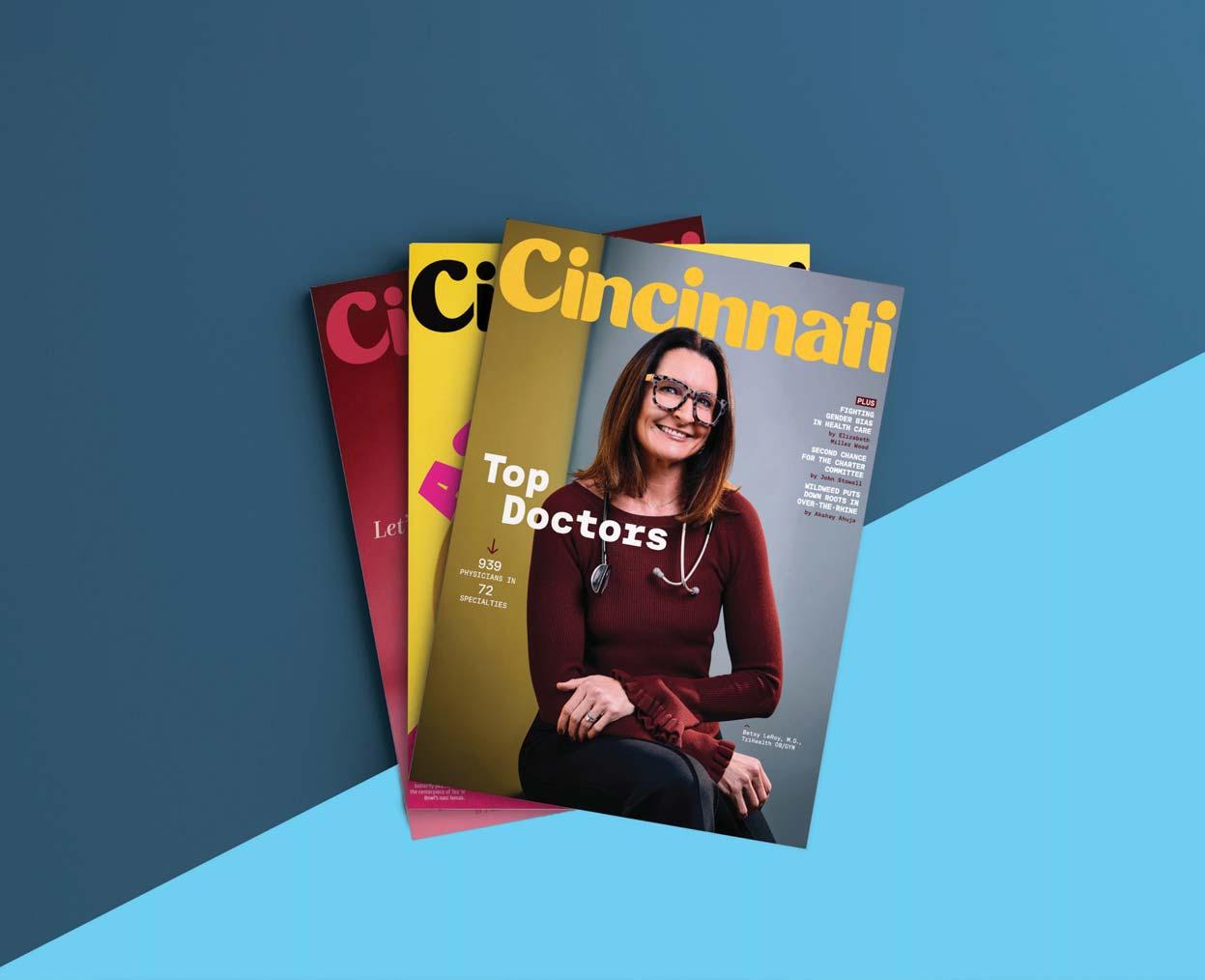










Our lavish four-night dinner series returns to celebrate the bounty of fall. Be sure to #savorthedate for this November 4–7 | 6–9:30 p.m.

SPONSORS PRESENTING SPONSOR


















CEO
METRO/SORTA
PRESIDENT
JEFF RUBY CULINARY ENTERTAINMENT
WHAT’S COMING UP FOR JEFF RUBY CULINARY ENTERTAINMENT? Our primary focus is on what we do best: delivering exceptional service and hospitality grounded in our core values. With the opening of The Lempicka by Jeff Ruby in June 2023 and the launch of Jeff Ruby Catering & Events in June 2024, our two newest ventures are
where our energy is currently centered. These natural extensions allow us to deliver an elevated, whiteglove approach to hospitality in new and exciting ways.
ARE YOU CONSIDERING NEW CITIES FOR ADDITIONAL EXPANSION? The Ruby family has always approached expansion with great intentionality. We don’t
follow an aggressive growth model and are highly selective about where and when we grow. Each opportunity is evaluated carefully to ensure it’s the right fit. While we’re always open to conversations and actively exploring possibilities, there are no confirmed plans at this time.
ASK ME ABOUT The company’s next growth opportunities.
HOW WILL YOUR PREVIOUS ROLE AS CFO INFORM YOUR LEADERSHIP AS PRESIDENT? Serving as CFO provided me with a deep understanding of the business from a strategic and financial perspective, which reinforced the importance of sustainable growth, disciplined data-driven decision-making, and investing in people. So I’m
able to bridge this vision with day-to-day execution, ensuring we remain true to who we are while also evolving in a way that’s fiscally sound. Most importantly, it enables me to support our teams with the clarity, resources, and leadership they need to succeed at the highest level.
–ELIZABETH MILLER WOOD
ASK ME ABOUT Next steps for the “Reinventing Metro” plan.
WHAT COMPELLED YOU TO BRING THE AUSCHWITZ EXHIBIT (OPENING OCTOBER 18) TO THE MUSEUM CENTER? It presents a unique opportunity for us to share the critically important stories of Auschwitz and its survivors in a way many people have not or may not get to experience otherwise. Union Terminal itself is a part of that history, both for liberators and survivors who passed under its rotunda. With our partners at the Nancy & David Wolf Holocaust & Humanity Center, this space is part of the education, healing, and resilience that continues today.
WHAT ARE SOME EXHIBIT HIGHLIGHTS? It features more than 500 original artifacts and 400 photographs from the Auschwitz-Birkenau State Museum and 20 other international museums, making this one of the largest display of artifacts
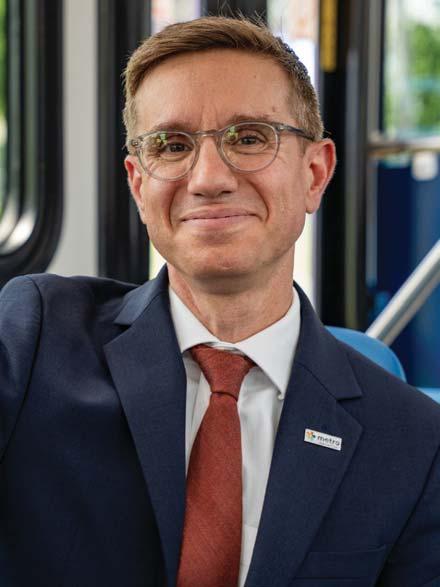
from Auschwitz outside of Europe. Among them are personal items that belonged to Auschwitz survivors and victims, including suitcases, eyeglasses, and shoes. The exhibition also contains concrete posts that formed part of the fence around the Auschwitz camp, fragments of an original prisoner barracks, and items from the world of the perpetrators of these atrocities, including gas masks.
WHAT EFFECT DO YOU HOPE THE EXHIBIT WILL HAVE? The history and story of Auschwitz can feel so dark, so overwhelming, that it doesn’t seem real. This exhibition demystifies Auschwitz in a way that encourages you to bear witness, confront the history of the Holocaust, and connect with the survivors and those who perished there. It helps make the lessons learned in that terrible place very clear so that we can confront the destructive power of hate in our time.
–E.M.W.
HOW WILL YOUR EXPERIENCE AT TANK BE APPLIED TO YOUR NEW ROLE WITH METRO/SORTA?
My 18 years of experience at TANK allowed me to learn nearly every part of the transit business. I played a hands-on role in the daily operation of the bus business, and I also gained a deep understanding of how transit systems are funded, from passenger fares to federal funding
PRESIDENT AND CEO
CINCINNATI MUSEUM CENTER
ASK ME ABOUT Why
CMC is hosting the traveling exhibit Auschwitz: Not Long Ago. Not Far Away.
programs and everything in between.
WHAT ARE THE UPCOMING STEPS OF METRO’S EXPANSION PLAN?
Metro has completed the first three of five phases to improve the fixedroute transit network. Phase four of these improvements rolls out this fall. Metro has also launched three of six planned MetroNow! zones with the fourth zone coming later
in 2025. Our largest project, the MetroRapid bus rapid transit project, is in the design phase with construction slated to begin in 2026.
HOW DO YOU HOPE THE REINVENTING METRO PLAN WILL IMPACT OUR COMMUNITY? These improvements have already had a huge positive impact on our region. Metro is one of the few U.S. transit systems that’s carrying more passen-
gers than we did before the pandemic. We have added 24-hour bus routes and cross-town routes and are improving access to jobs, education, medical appointments, and more. As we improve our region’s transit system, we’re driving more economic growth and creating more opportunity for everyone.
–E.M.W.






The OneNKY Center opens in Covington to help regional growth organizations collaborate with the community and each other.
–JOHN FOX
PHOTOGRAPHS BY CHRIS VON HOLLE










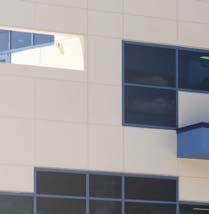


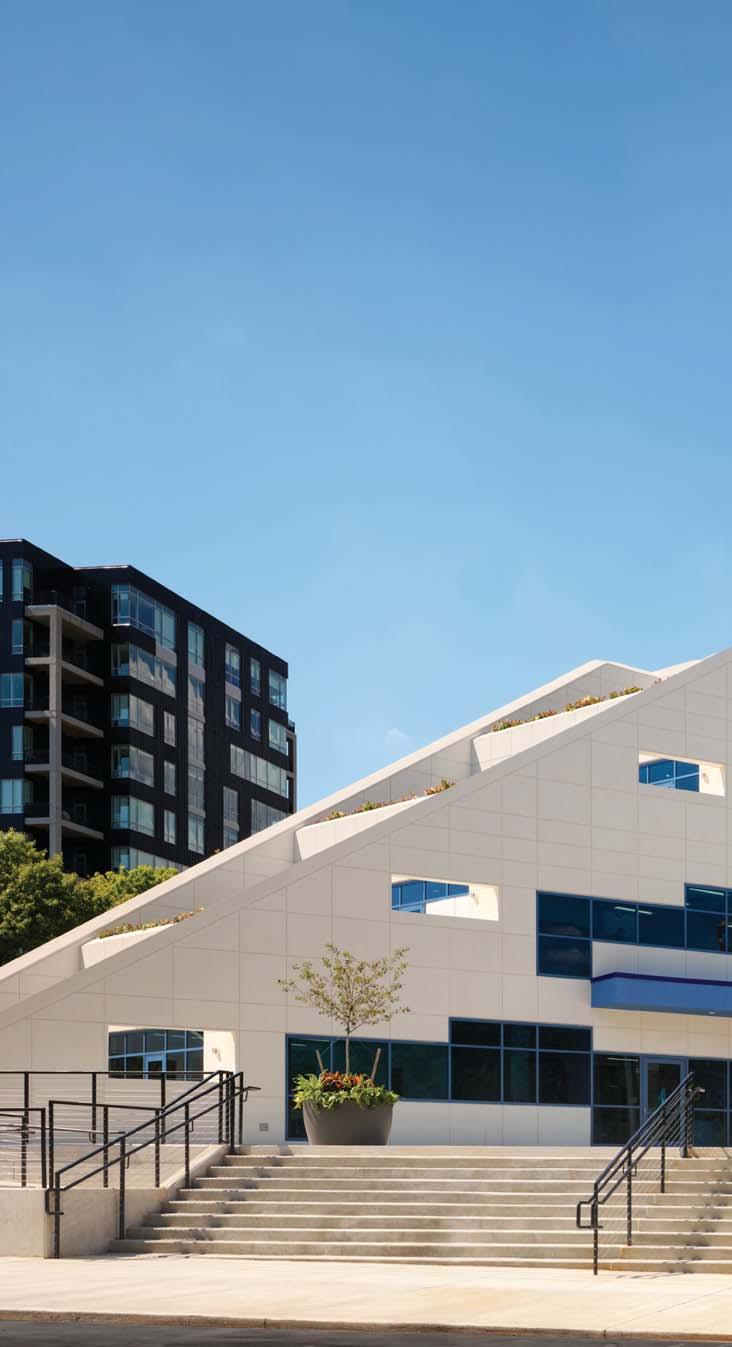

With complementary designs,


The Northern Kentucky Port Authority developed the OneNKY Center with $10 million in construction bonds issued by Kenton County Fiscal Court and with The Catalytic Fund of Northern Kentucky incubating the concept after years of discussion and planning. The $26-million four-story building opened in September with 47,000 total square feet of office, laboratory, and community space.
The Northern Kentucky Bar Association’s third floor office (top) was designed by Platte Architecture + Design to welcome attorneys for coworking, events, and meetings. BLDG designed the artwork in meetNKY’s lobby (middle on opposite page) to reflect the region’s history and future, including a new regional brand. The horse figure is on loan from Behringer-Crawford Museum and is a relic from the White Horse Tavern, a Ft. Mitchell restaurant that burned down in 1972. The Corporex Community Board Room (bottom) hired Emboss Design to create a custom-built table that follows the curve of the building and room.
The ground floor St. Elizabeth Unity Lounge, designed by Emboss Design, will serve as a meeting space and an art gallery in partnership with ArtsWave (orange couch above). An artist-in-residence program is expected to launch in the spring.
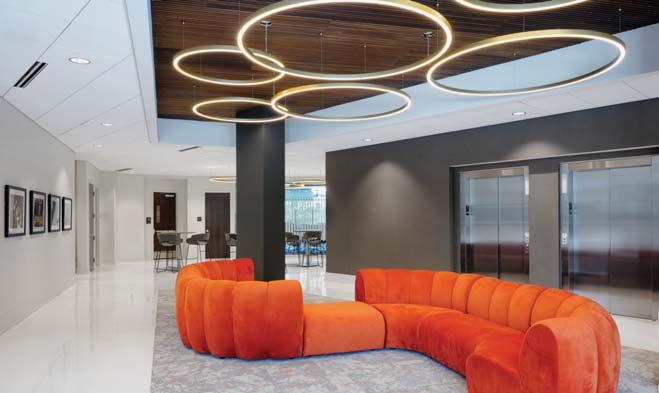


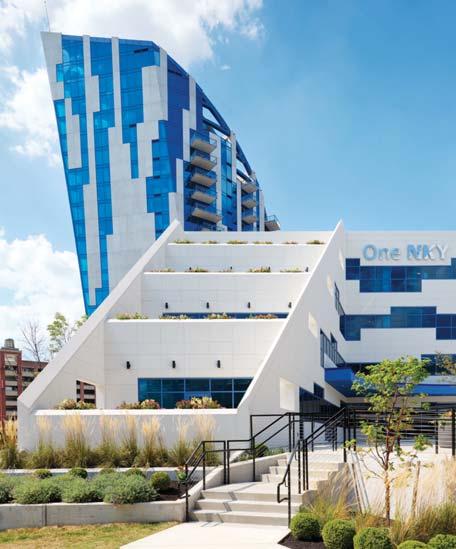
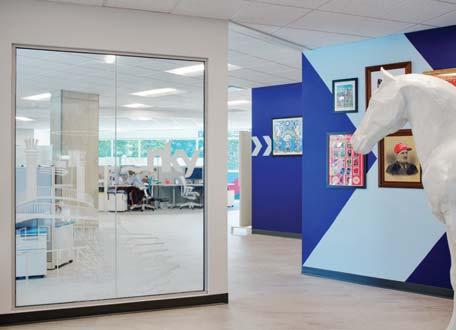
SHP designed BE NKY Growth Partnership’s hospitality space (bottom) to showcase views of the Roebling Suspension Bridge and the downtown Cincinnati skyline. Other organizations relocating to the OneNKY Center include OneNKY Alliance, Northern Kentucky Chamber of Commerce, Horizon Community Funds of Northern Kentucky, and The Catalytic Fund.
The Commonwealth of Kentucky provided $15 million in funding to establish LifeSciKY on the building’s second floor, which will offer 15,000 square feet of life sciences labs and startup space (below). Tenants are still to be announced.


This fall, Cincinnati State reached its highest fall enrollment in 12 years–up 12.7% from last year. At the same time, the Ohio Department of Higher Education ranks our graduates #1 in Ohio for community college earnings–averaging $54,308 a year!


































As director of the Howe Center for Writing Excellence at Miami University, Elizabeth Wardle has decades of experience helping writers of all kinds redefine how they approach the craft. Her new book, “Writing Rediscovered: Nine Concepts to Transform Your Relationship with Writing,” dives deep into what’s holding you back from seeing yourself as a writer. You’ll challenge your beliefs about writers and writing, and gain tools to take your writing to the next level — whether you are writing for work or pleasure.




























